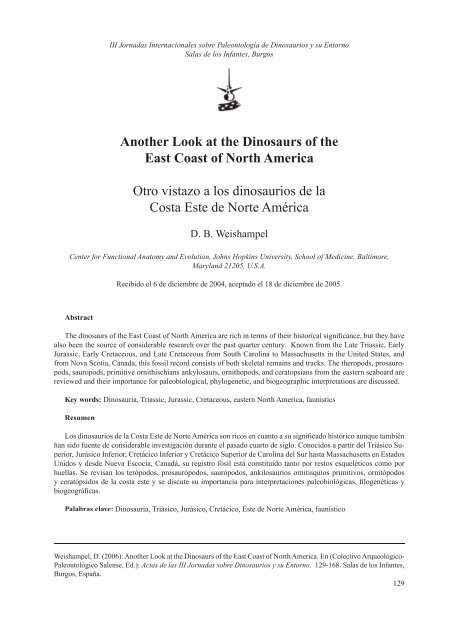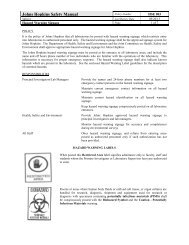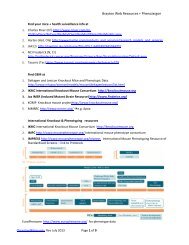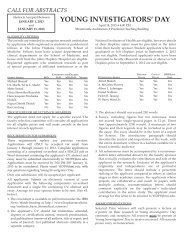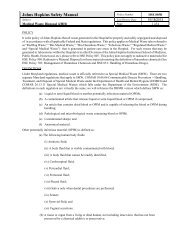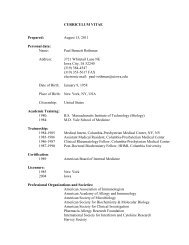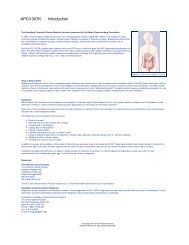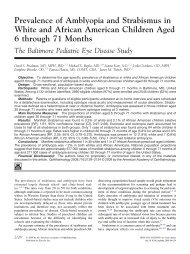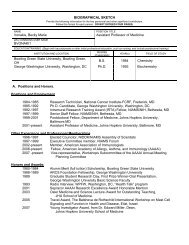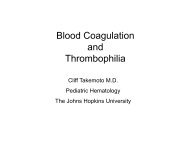Another Look at the Dinosaurs of the East Coast of North America ...
Another Look at the Dinosaurs of the East Coast of North America ...
Another Look at the Dinosaurs of the East Coast of North America ...
Create successful ePaper yourself
Turn your PDF publications into a flip-book with our unique Google optimized e-Paper software.
III Jornadas Internacionales sobre Paleontología de Dinosaurios y su Entorno<br />
Salas de los Infantes, Burgos<br />
<strong>Ano<strong>the</strong>r</strong> <strong>Look</strong> <strong>at</strong> <strong>the</strong> <strong>Dinosaurs</strong> <strong>of</strong> <strong>the</strong><br />
<strong>East</strong> <strong>Coast</strong> <strong>of</strong> <strong>North</strong> <strong>America</strong><br />
Otro vistazo a los dinosaurios de la<br />
Costa Este de Norte América<br />
D. B. Weishampel<br />
Center for Functional An<strong>at</strong>omy and Evolution, Johns Hopkins University, School <strong>of</strong> Medicine, Baltimore,<br />
Maryland 21205, U.S.A.<br />
Abstract<br />
Recibido el 6 de diciembre de 2004, aceptado el 18 de diciembre de 2005.<br />
The dinosaurs <strong>of</strong> <strong>the</strong> <strong>East</strong> <strong>Coast</strong> <strong>of</strong> <strong>North</strong> <strong>America</strong> are rich in terms <strong>of</strong> <strong>the</strong>ir historical signifi cance, but <strong>the</strong>y have<br />
also been <strong>the</strong> source <strong>of</strong> considerable research over <strong>the</strong> past quarter century. Known from <strong>the</strong> L<strong>at</strong>e Triassic, Early<br />
Jurassic, Early Cretaceous, and L<strong>at</strong>e Cretaceous from South Carolina to Massachusetts in <strong>the</strong> United St<strong>at</strong>es, and<br />
from Nova Scotia, Canada, this fossil record consists <strong>of</strong> both skeletal remains and tracks. The <strong>the</strong>ropods, prosauropods,<br />
sauropods, primitive ornithischians ankylosaurs, ornithopods, and cer<strong>at</strong>opsians from <strong>the</strong> eastern seaboard are<br />
reviewed and <strong>the</strong>ir importance for paleobiological, phylogenetic, and biogeographic interpret<strong>at</strong>ions are discussed.<br />
Key words: Dinosauria, Triassic, Jurassic, Cretaceous, eastern <strong>North</strong> <strong>America</strong>, faunistics<br />
Resumen<br />
Los dinosaurios de la Costa Este de Norte América son ricos en cuanto a su signifi cado histórico aunque también<br />
han sido fuente de considerable investigación durante el pasado cuarto de siglo. Conocidos a partir del Triásico Superior,<br />
Jurásico Inferior, Cretácico Inferior y Cretácico Superior de Carolina del Sur hasta Massachusetts en Estados<br />
Unidos y desde Nueva Escocia, Canadá, su registro fósil está constituido tanto por restos esqueléticos como por<br />
huellas. Se revisan los terópodos, prosaurópodos, saurópodos, ankilosaurios ornitisquios primitivos, ornitópodos<br />
y cer<strong>at</strong>ópsidos de la costa este y se discute su importancia para interpretaciones paleobiológicas, fi logenéticas y<br />
biogeográfi cas.<br />
Palabras clave: Dinosauria, Triásico, Jurásico, Cretácico, Este de Norte América, faunístico<br />
Weishampel, D. (2006): <strong>Ano<strong>the</strong>r</strong> <strong>Look</strong> <strong>at</strong> <strong>the</strong> <strong>Dinosaurs</strong> <strong>of</strong> <strong>the</strong> <strong>East</strong> <strong>Coast</strong> <strong>of</strong> <strong>North</strong> <strong>America</strong>. En (Colectivo Arqueológico-<br />
Paleontológico Salense, Ed.): Actas de las III Jornadas sobre Dinosaurios y su Entorno. 129-168. Salas de los Infantes,<br />
Burgos, España.<br />
129
130<br />
Introduction<br />
D.B. WEISHAMPEL<br />
It has been nearly two centuries since <strong>the</strong> fi rst dinosaur was discovered along <strong>the</strong> eastern<br />
seaboard <strong>of</strong> <strong>North</strong> <strong>America</strong> (an indetermin<strong>at</strong>e prosauropod discovered in 1818, fi rst recognized<br />
as dinosaurian by Galton 1976) and eight years since <strong>the</strong> public<strong>at</strong>ion <strong>of</strong> <strong>the</strong> most recent tre<strong>at</strong>ment<br />
<strong>of</strong> all <strong>the</strong> <strong>East</strong> <strong>Coast</strong> dinosaurs (Weishampel and Young 1996). Despite its historical signifi cance,<br />
research on <strong>the</strong>se dinosaurs was eclipsed by <strong>the</strong> gre<strong>at</strong> dinosaur rush in <strong>the</strong> Western Interior <strong>of</strong> <strong>the</strong><br />
United St<strong>at</strong>es in <strong>the</strong> l<strong>at</strong>e 19th century and l<strong>at</strong>er, in <strong>the</strong> 1910s and 1920s, in western Canada. After<br />
th<strong>at</strong>, <strong>the</strong>re was no looking back as amazing discoveries were made elsewhere, such th<strong>at</strong> now<br />
dinosaurs are well known from spectacular occurrences across <strong>the</strong> globe (Weishampel and White<br />
2003, Weishampel et al. 2004).<br />
The dinosaurs <strong>of</strong> <strong>the</strong> <strong>East</strong> <strong>Coast</strong> <strong>of</strong> <strong>North</strong> <strong>America</strong>, despite <strong>the</strong>ir rarity and rel<strong>at</strong>ively poor<br />
preserv<strong>at</strong>ion, have had an important infl uence on our understanding <strong>of</strong> dinosaurian faunistics,<br />
paleobiology, phylogeny, and biogeography. In wh<strong>at</strong> follows, I will summarize wh<strong>at</strong> is known<br />
about <strong>the</strong> dinosaurs along <strong>the</strong> eastern seaboard and how <strong>the</strong>y fi t into contemporary issues in<br />
dinosaur research.<br />
Distribution<br />
<strong>Dinosaurs</strong> are known from a discontinuous 100-km wide sw<strong>at</strong>h <strong>of</strong> <strong>the</strong> Atlantic <strong>Coast</strong>al Plain<br />
extending from Nova Scotia in <strong>the</strong> north to South Carolina to <strong>the</strong> south (Fig. 1; Weishampel and<br />
Young 1996). Str<strong>at</strong>igraphically, <strong>the</strong> best record (though consisting nearly entirely <strong>of</strong> ichn<strong>of</strong>ossils)<br />
comes from <strong>the</strong> geographically disjunct rift valleys th<strong>at</strong> formed during <strong>the</strong> L<strong>at</strong>e Triassic and<br />
Early Jurassic, preserved in wh<strong>at</strong> is now a belt from <strong>North</strong> Carolina to Nova Scotia. The <strong>East</strong><br />
<strong>Coast</strong> record <strong>of</strong> dinosaurs is absent <strong>the</strong>reafter until <strong>the</strong> Early Cretaceous. This 160 million year<br />
long Jurassic hi<strong>at</strong>us is followed by a modest, but important fauna from <strong>the</strong> mid-Atlantic region.<br />
Finally, <strong>the</strong>re are several well-known, but p<strong>at</strong>chy dinosaur faunas distributed throughout <strong>the</strong> L<strong>at</strong>e<br />
Cretaceous from New Jersey, Delaware, and Maryland. These faunas provide <strong>the</strong> best body<br />
fossil record <strong>of</strong> all <strong>the</strong> <strong>East</strong> <strong>Coast</strong> dinosaurs.<br />
The rarity <strong>of</strong> discoveries <strong>of</strong> dinosaurs along <strong>the</strong> eastern seaboard <strong>of</strong> <strong>North</strong> <strong>America</strong> is<br />
certainly unfortun<strong>at</strong>e when <strong>at</strong>tempts are made to compare wh<strong>at</strong> has been uncovered with<br />
<strong>the</strong> faunas known from elsewhere in <strong>the</strong> world. The biases against <strong>the</strong>ir preserv<strong>at</strong>ion are<br />
obvious. First and foremost, much <strong>of</strong> <strong>the</strong> Mesozoic record is absent in <strong>the</strong> Appalachian region<br />
and along <strong>the</strong> Atlantic <strong>Coast</strong>al Plain (Weishampel et al. 2004), so <strong>the</strong> possibilities for having<br />
access to <strong>the</strong> appropri<strong>at</strong>e str<strong>at</strong>a are limited. Second, human activity along <strong>the</strong> <strong>East</strong> <strong>Coast</strong> has<br />
fur<strong>the</strong>r reduced access to wh<strong>at</strong>ever outcrops may be available. For example, much <strong>of</strong> <strong>the</strong><br />
eastern seaboard has been ei<strong>the</strong>r paved over (<strong>the</strong> roads, <strong>of</strong>fi ce buildings, homes, malls, etc.<br />
III Jornadas Internacionales sobre Paleontología de Dinosaurios y su Entorno
<strong>Ano<strong>the</strong>r</strong> <strong>Look</strong> <strong>at</strong> <strong>the</strong> <strong>Dinosaurs</strong> <strong>of</strong> <strong>the</strong> <strong>East</strong> <strong>Coast</strong> <strong>of</strong> <strong>North</strong> <strong>America</strong><br />
Figure 1. General geographic distribution <strong>of</strong> <strong>the</strong> dinosaurs <strong>of</strong> <strong>the</strong> <strong>East</strong> <strong>Coast</strong> <strong>of</strong> <strong>North</strong> <strong>America</strong>. Sym-<br />
bols: : L<strong>at</strong>e Triassic; : Early Jurassic; : Early Cretaceous; : L<strong>at</strong>e Cretaceous.<br />
th<strong>at</strong> constitute <strong>the</strong> Atlanta-Boston “megalopolis”) or dedic<strong>at</strong>ed to agriculture. If it had not been<br />
for <strong>the</strong> cre<strong>at</strong>ion <strong>of</strong> outcrop through commercial mining during <strong>the</strong> 1800s (i.e., surface mining<br />
for brownstone building m<strong>at</strong>erial in New England, bog iron in Maryland and glauconite in New<br />
Jersey; Guinness 2003, Singewald 1911, Gallagher 1997), much <strong>of</strong> <strong>the</strong> historically signifi cant<br />
fossil discoveries would never have been made. Today we rely mostly on <strong>the</strong> occasional new<br />
road cuts, construction sites, and along river banks for <strong>the</strong> opening-up <strong>of</strong> pockets <strong>of</strong> sediment<br />
and, with luck, <strong>the</strong>ir included fossils.<br />
From a paleogeographic and paleoecological perspective, <strong>the</strong> dinosaurs <strong>of</strong> <strong>the</strong> L<strong>at</strong>e Triassic-<br />
Early Jurassic interval (Carnian-Toarcian) are found in cyclically deposited sandstones, shales,<br />
and black argillites, indic<strong>at</strong>ing <strong>the</strong> presence <strong>of</strong> alluvial fans, rivers and fl oodplains, lakes, and<br />
eolian conditions (LeTourneau 2003, Tanner 2003). The cyclicity <strong>of</strong> <strong>the</strong>se beds corresponds to<br />
repetitive clim<strong>at</strong>ic shifts between semiarid and wet seasons (Tanner 2003).<br />
Salas de los Infantes, Burgos 131
132<br />
D.B. WEISHAMPEL<br />
During <strong>the</strong> Early Cretaceous, wh<strong>at</strong> was to become an extensive epicontinental seaway (Western<br />
Interior Seaway) th<strong>at</strong> isol<strong>at</strong>ed western <strong>North</strong> <strong>America</strong> (Laramidia) from its eastern counterpart<br />
(Appalachia) in <strong>the</strong> mid-Cretaceous, developed in <strong>the</strong> north <strong>of</strong> this continental landmass<br />
(Archibald 1996). The sole Early Cretaceous dinosaur fauna from <strong>the</strong> <strong>East</strong> <strong>Coast</strong> (<strong>the</strong> Arundel<br />
Clay fauna; Aptian) has been recovered from dark gray and maroon lignitic clays th<strong>at</strong> also include<br />
abundant iron carbon<strong>at</strong>e concretions. Thought to be <strong>the</strong> remnants <strong>of</strong> successive oxbow lakes and<br />
fl uviodeltaic back-swamps developed along <strong>the</strong> eastern piedmont <strong>of</strong> <strong>the</strong> Appalachian Mountains<br />
(Glaser 1969). The iron nodules formed <strong>the</strong> basis for <strong>the</strong> iron manufacturing industry <strong>of</strong> eastern<br />
Maryland and Virginia, which had been in its heyday in <strong>the</strong> 18th and early 19th centuries, but was<br />
in decline when fossils were initially found here <strong>the</strong>reafter (Singewald 1911, Kranz 1998).<br />
The L<strong>at</strong>e Cretaceous dinosaur faunas are known from sequences <strong>of</strong> marine rocks exposed<br />
along <strong>the</strong> eastern margin <strong>of</strong> <strong>the</strong> Cretaceous outcrop belt th<strong>at</strong> extends from New Jersey to South<br />
Carolina (Gallagher 1984, 1993, Weishampel and Young 1996). These str<strong>at</strong>a, mostly glauconitic<br />
sands and brown clays, record a series <strong>of</strong> transgressive-regressive shallow marine cycles during<br />
<strong>the</strong> l<strong>at</strong>est Cretaceous (Campanian-Maastrichtian) and into <strong>the</strong> Tertiary.<br />
<strong>East</strong> <strong>Coast</strong> <strong>Dinosaurs</strong><br />
L<strong>at</strong>e Triassic<br />
As has been well documented, <strong>the</strong> L<strong>at</strong>e Triassic faunas <strong>of</strong> <strong>the</strong> <strong>East</strong> <strong>Coast</strong> are domin<strong>at</strong>ed by<br />
ichnotaxa, while body fossils are rare (Olsen 1980a, b, 1997, Olsen and Flynn 1989, Weishampel<br />
and Young 1996). From <strong>the</strong>ir fi rst discovery in 1886 (Eyerman 1886) until <strong>the</strong> present, only<br />
<strong>the</strong>ropods and primitive ornithischians are <strong>at</strong> all well known. The L<strong>at</strong>e Triassic record <strong>of</strong><br />
prosauropods is both enigm<strong>at</strong>ic and controversial, consisting <strong>of</strong> a few teeth from Nova Scotia<br />
and an ichnotaxon from Virginia.<br />
L<strong>at</strong>e Triassic <strong>the</strong>ropods from <strong>the</strong> <strong>East</strong> <strong>Coast</strong> are presently known only from tracks and<br />
trackways (Olsen 1980a, b, Olsen et al. 2002, Weishampel and Young 1996). Their footprints<br />
– all from <strong>the</strong> pes, indic<strong>at</strong>ing <strong>the</strong> track maker was bipedal – have been given a wide variety <strong>of</strong><br />
generic and specifi c design<strong>at</strong>ions depending on <strong>the</strong>ir size. Ranging from 5-15 cm in length, all<br />
Grall<strong>at</strong>or footprints (among <strong>the</strong>m G. cursorius and G. tenuis<br />
) have a digital formula <strong>of</strong> ?-3-4-5-<br />
?, terminal claw marks, <strong>the</strong> impression <strong>of</strong> a heel, and <strong>the</strong> trace <strong>of</strong> digit I to <strong>the</strong> rear <strong>of</strong> <strong>the</strong> track<br />
(Fig. 2; see G<strong>at</strong>esy et al. 1999 for functional interpret<strong>at</strong>ions <strong>of</strong> this track p<strong>at</strong>tern). The impression<br />
<strong>of</strong> digit III is always <strong>the</strong> longest, while those <strong>of</strong> digits II and IV are subequal in length. With all<br />
<strong>the</strong>se fe<strong>at</strong>ures in common, it is <strong>of</strong>ten <strong>the</strong> size <strong>of</strong> <strong>the</strong> prints th<strong>at</strong> determines <strong>the</strong> names applied to<br />
<strong>the</strong>m. First described by Hitchcock in 1858, Grall<strong>at</strong>or prints are abundant and widely distributed<br />
from Virginia to Nova Scotia along <strong>the</strong> eastern seaboard during <strong>the</strong> L<strong>at</strong>e Triassic.<br />
III Jornadas Internacionales sobre Paleontología de Dinosaurios y su Entorno
<strong>Ano<strong>the</strong>r</strong> <strong>Look</strong> <strong>at</strong> <strong>the</strong> <strong>Dinosaurs</strong> <strong>of</strong> <strong>the</strong> <strong>East</strong> <strong>Coast</strong> <strong>of</strong> <strong>North</strong> <strong>America</strong><br />
Figure 2. Pedal track <strong>of</strong> Grall<strong>at</strong>or, thought to have been made by a cer<strong>at</strong>osaurian <strong>the</strong>ropod, L<strong>at</strong>e<br />
Triassic and Early Jurassic. Scale = 5 cm (after Lull 1953).<br />
Often found with Grall<strong>at</strong>or are 5-25 cm long pedal prints th<strong>at</strong> have been named<br />
Anchisauripus,<br />
fi rst described by Lull (1904) as <strong>the</strong> probable track <strong>of</strong> <strong>the</strong> prosauropod dinosaur Anchisaurus.<br />
Olsen (1980b) suggested th<strong>at</strong> Anchisauripus tracks were made not by a prosauropod but instead<br />
are <strong>the</strong> footprints <strong>of</strong> large individuals <strong>of</strong> <strong>the</strong> Grall<strong>at</strong>or track maker.<br />
The third <strong>of</strong> <strong>the</strong>se L<strong>at</strong>e Triassic footprints is Kayentapus (Weems 1987), which appear to come<br />
from a different <strong>the</strong>ropod track maker than Grall<strong>at</strong>or. The <strong>East</strong> <strong>Coast</strong> Kayentapus tracks are<br />
large – 30 cm long – with a much longer, claw-tipped digit III and subequal, diverging digits II<br />
and IV. The digital formula <strong>of</strong> Kayentapus is <strong>the</strong> same as for Grall<strong>at</strong>or.<br />
Judging from <strong>the</strong> size <strong>of</strong> <strong>the</strong> prints, <strong>the</strong> animal responsible for <strong>the</strong>se Grall<strong>at</strong>or tracks was 2-6<br />
m long, whereas <strong>the</strong> Kayentapus trackmaker was probably 3-4 m long. Based on <strong>the</strong>ir form and<br />
size, <strong>the</strong> maker <strong>of</strong> Kayentapus tracks has been likened to Dilophosaurus, a 6 m long <strong>the</strong>ropod<br />
known from <strong>the</strong> Early Jurassic <strong>of</strong> Arizona, whereas a Coelophysis-like <strong>the</strong>ropod (i.e., 1-2 m long,<br />
also known from <strong>the</strong> desert Southwestern United St<strong>at</strong>es, but from beds roughly contemporary<br />
with those in <strong>the</strong> east (i.e., L<strong>at</strong>e Triassic), is thought to have made <strong>the</strong> Grall<strong>at</strong>or tracks.<br />
Prosauropoda<br />
Although known elsewhere as <strong>the</strong> fi rst large browsers <strong>of</strong> <strong>the</strong> Mesozoic, <strong>the</strong> L<strong>at</strong>e Triassic<br />
prosauropods are poorly represented on <strong>the</strong> <strong>East</strong> <strong>Coast</strong>. Only a few badly preserved bony and dental<br />
specimens are known from Nova Scotia (Olsen et al. 1982) and Pennsylvania, and some indistinct<br />
pedal prints from Culpeper th<strong>at</strong> may have been made by a prosauropod known as Agrestipus ho-<br />
Salas de los Infantes, Burgos 133
134<br />
D.B. WEISHAMPEL<br />
ttoni (Weems 1987). The taxonomy <strong>of</strong> <strong>the</strong> body fossils cannot be ascertained with any certainty<br />
and may in fact not be prosauropod (or even dinosaurian) in affi nity. The duck-like pes prints <strong>of</strong><br />
Agrestipus reveal three, and sometimes four, blunt digits. Originally thought to have been made<br />
by a sauropod dinosaur (Weems 1987), <strong>the</strong>y are probably prosauropod prints because <strong>of</strong> <strong>the</strong>ir<br />
bipedal occurrence.<br />
Ornithischians<br />
The record <strong>of</strong> ornithischian dinosaurs presently consists <strong>of</strong> a few teeth and a single ichnotaxon.<br />
Of <strong>the</strong> dental m<strong>at</strong>erial, Galtonia gibbidens is represented by several teeth collected in <strong>the</strong> mid-<br />
1800s from near Emigsville, Pennsylvania (Cope 1878, Hunt and Lucas 1994). The teeth were<br />
originally described by Cope (1878) as <strong>the</strong> prosauropod dinosaur Thecodontosaurus gibbidens,<br />
based on similarities with Thecodontosaurus antiquus from England (Riley and Stutchbury 1836,<br />
1840; see also Benton et al. 2000) and were fi rst <strong>at</strong>tributed to Ornithischia by Galton (1983).<br />
Hunt and Lucas (1994) named <strong>the</strong>se teeth Galtonia gibbidens. The o<strong>the</strong>r tooth taxon from <strong>the</strong><br />
L<strong>at</strong>e Triassic <strong>of</strong> <strong>the</strong> Atlantic <strong>Coast</strong>al Plain is Pekinosaurus olseni, also named by Hunt and Lucas<br />
(1994) based on several ornithischian teeth collected in Paul Olsen near <strong>the</strong> town <strong>of</strong> Pekin, <strong>North</strong><br />
Carolina. No more than 5-6 mm high and broadly triangular, <strong>the</strong>se fe<strong>at</strong>ures are found in o<strong>the</strong>r<br />
primitive ornithischians as well. Thus Galtonia and Pekinosaurus<br />
appear to represent primitive,<br />
but indetermin<strong>at</strong>e ornithischians (Fig. 3; Norman et al. 2004). O<strong>the</strong>r indetermin<strong>at</strong>e ornithischian<br />
dental m<strong>at</strong>erial consists <strong>of</strong> a fragmentary and very small maxilla with teeth (Galton 1983).<br />
In contrast to this rarity <strong>of</strong> <strong>the</strong>se skeletal remains on <strong>the</strong> <strong>East</strong> <strong>Coast</strong>, ornithischian footprints<br />
and trackways are abundant, particularly <strong>the</strong> print known as Atreipus (Fig. 4). There are several<br />
kinds <strong>of</strong> <strong>the</strong> quadrupedal Atreipus, among <strong>the</strong>m Atreipus milfordensis and A. acadianus. Among<br />
<strong>the</strong> oldest dinosaur footprints on <strong>the</strong> <strong>East</strong> <strong>Coast</strong> are Atreipus tracks discovered <strong>at</strong> Leaksville<br />
Junction on <strong>the</strong> border <strong>of</strong> Virginia and <strong>North</strong> Carolina, currently under study by Olsen and Fraser.<br />
Atreipus is so common and suffi ciently restricted in time –known only from about a 10 million<br />
year period – th<strong>at</strong> it is <strong>of</strong>ten used as an index fossil for part <strong>of</strong> <strong>the</strong> L<strong>at</strong>e Triassic (Olsen and Baird<br />
1986). The three digit pedal prints <strong>of</strong> Atreipus have a long digit III and digits II and IV th<strong>at</strong> are<br />
shorter than digit III but equal in length to each o<strong>the</strong>r. Its digital formula is ?-3-4-5-? (digits I<br />
and V, if present, were not preserved as prints). On <strong>the</strong> basis <strong>of</strong> <strong>the</strong> pedal and manual footprints,<br />
<strong>the</strong> maker <strong>of</strong> Atreipus tracks was an animal similar to Lesothosaurus, a basal ornithischian from<br />
sou<strong>the</strong>rn Africa (Olsen and Baird 1986).<br />
Gregaripus bairdi is a less common ornithischian track maker from this interval <strong>of</strong> time.<br />
Named by Weems (1987), <strong>the</strong>se tracks have been found in only one loc<strong>at</strong>ion: <strong>the</strong> upper <strong>of</strong> two<br />
footprint horizons <strong>at</strong> <strong>the</strong> stone and gravel quarry near Culpeper, Virginia. Gregaripus tracks are<br />
blunt, tridactyl, and small, less than 10 cm long.<br />
III Jornadas Internacionales sobre Paleontología de Dinosaurios y su Entorno
<strong>Ano<strong>the</strong>r</strong> <strong>Look</strong> <strong>at</strong> <strong>the</strong> <strong>Dinosaurs</strong> <strong>of</strong> <strong>the</strong> <strong>East</strong> <strong>Coast</strong> <strong>of</strong> <strong>North</strong> <strong>America</strong><br />
Figure 3. a. Premaxillary tooth <strong>of</strong> Galtonia gibbidens. b. Pekinosaurus olseni, both indetermin<strong>at</strong>e<br />
primitive ornithischians, L<strong>at</strong>e Triassic. Scale = 2 mm (after Hunt and Lucas 1994).<br />
Figure 4. Manual and pedal tracks <strong>of</strong> Atreipus, thought to have been made by a primitive ornithischian,<br />
L<strong>at</strong>e Triassic. Scale = 1 cm (after Olsen and Baird 1986).<br />
Early Jurassic<br />
The last part <strong>of</strong> <strong>the</strong> Triassic was marked by <strong>at</strong> least one mass extinction. Among vertebr<strong>at</strong>es,<br />
procolophonids, phytosaurs, rhynchosaurs, dicynodonts, cynodonts, and many archosaur taxa<br />
are lost (many compendia <strong>of</strong> <strong>the</strong> “winners and losers” across <strong>the</strong> Triassic-Jurassic boundary are<br />
available; here I cite Benton 1983, 1994, Fraser and Sues 1994, Padian 1994, Olsen et al. 2002,<br />
but <strong>the</strong>re are many o<strong>the</strong>rs). This extirp<strong>at</strong>ion has been linked to competition among archosaurian<br />
and non-mammalian <strong>the</strong>rapsids (Charig 1984), rapid clim<strong>at</strong>e change (Benton 1983, 1994; see<br />
Salas de los Infantes, Burgos 135
136<br />
D.B. WEISHAMPEL<br />
also this volume), and bolide impact (Olsen et al. 2002). Wh<strong>at</strong>ever <strong>the</strong> cause, it is clear<br />
th<strong>at</strong> new major taxa have <strong>the</strong>ir origin during earliest Jurassic times, and th<strong>at</strong> pterosaurs,<br />
turtles, and dinosaurs survived <strong>the</strong> extinction event (Benton 1994, Olsen et al. 2002).<br />
Theropoda<br />
The fossil record for Early Jurassic <strong>the</strong>ropod dinosaurs fi ts <strong>the</strong> same p<strong>at</strong>tern as for <strong>the</strong><br />
ornithischians: many footprints and trackways but few skeletal remains, with localities primarily<br />
in <strong>the</strong> Connecticut Valley, Newark Basin, and Fundy Basin.<br />
The fi rst adequ<strong>at</strong>e skeletal m<strong>at</strong>erial <strong>of</strong> <strong>East</strong> <strong>Coast</strong> dinosaurs is known from <strong>the</strong> Early<br />
Jurassic – a <strong>the</strong>ropod (Podokesaurus<br />
( ) and two prosauropods (Anchisaurus, ( Ammosaurus<br />
Ammosaurus).<br />
Unfortun<strong>at</strong>ely, <strong>the</strong> type and only specimen <strong>of</strong> Podokesaurus was destroyed in <strong>the</strong> fi re <strong>of</strong> 1916<br />
th<strong>at</strong> consumed Williston Hall on <strong>the</strong> campus <strong>of</strong> Mt. Holyoke College, where <strong>the</strong> specimen<br />
was kept. However, casts <strong>of</strong> Podokesaurus now reside <strong>at</strong> <strong>the</strong> Yale Peabody Museum and <strong>the</strong><br />
<strong>America</strong>n Museum <strong>of</strong> N<strong>at</strong>ural History. No additional m<strong>at</strong>erial has been referred unambiguously<br />
to Podokesaurus, so <strong>the</strong> signifi cance <strong>of</strong> this dinosaur came to depend on <strong>the</strong> original, poorly<br />
preserved skeleton.<br />
When fi rst discovered in 1910 in Massachusetts, this 1 m long <strong>the</strong>ropod was known from<br />
part <strong>of</strong> <strong>the</strong> vertebral column (including some <strong>of</strong> <strong>the</strong> tail), a fragmentary humerus, some ribs, a<br />
pubis and ischium, a partial left femur, and much <strong>of</strong> <strong>the</strong> right leg (Fig. 5). Although <strong>the</strong> bones<br />
were poorly preserved, Mignon Talbot described and named Podokesaurus holyokensis in 1911.<br />
Three years l<strong>at</strong>er, von Huene (1914) used Podokesaurus as <strong>the</strong> founding member <strong>of</strong> a new group<br />
<strong>of</strong> small <strong>the</strong>ropods, Podokesauridae, under <strong>the</strong> umbrella <strong>of</strong> <strong>the</strong> taxon he called Coelurosauria.<br />
At <strong>the</strong> same time, Lull (1915) reviewed Talbot’s earlier description and recognized additional<br />
fe<strong>at</strong>ures <strong>of</strong> <strong>the</strong> m<strong>at</strong>erial.<br />
Thereafter, except for <strong>the</strong> discovery in Connecticut <strong>of</strong> a n<strong>at</strong>ural cast <strong>of</strong> a pubis, tibia, and ribs<br />
very tent<strong>at</strong>ively referred to this taxon (Colbert and Baird 1858), Podokesaurus was to receive<br />
little <strong>at</strong>tention o<strong>the</strong>r than mere mention in taxonomic and faunistic studies. However, with<br />
<strong>the</strong> discovery <strong>of</strong> important new, well preserved, and abundant m<strong>at</strong>erial <strong>of</strong> <strong>the</strong> small <strong>the</strong>ropod<br />
Coelophysis in Upper Triassic rocks <strong>at</strong> Ghost Ranch, New Mexico (Colbert 1961, 1989), <strong>the</strong><br />
an<strong>at</strong>omy <strong>of</strong> small <strong>the</strong>ropods came into much better focus. Colbert (1964) compared <strong>the</strong> surviving<br />
casts <strong>of</strong> Podokesaurus with this new Coelophysis m<strong>at</strong>erial, concluding th<strong>at</strong> Podokesaurus and<br />
Coelophysis were synonymous, with Coelophysis having priority. Consequently, he called <strong>the</strong><br />
Massachusetts species Coelophysis holyokensis.<br />
As more <strong>the</strong>ropod m<strong>at</strong>erial came to light and <strong>the</strong> research issues shifted to <strong>the</strong>ropod phylo-<br />
III Jornadas Internacionales sobre Paleontología de Dinosaurios y su Entorno
<strong>Ano<strong>the</strong>r</strong> <strong>Look</strong> <strong>at</strong> <strong>the</strong> <strong>Dinosaurs</strong> <strong>of</strong> <strong>the</strong> <strong>East</strong> <strong>Coast</strong> <strong>of</strong> <strong>North</strong> <strong>America</strong><br />
Figure 5. Skeleton <strong>of</strong> <strong>the</strong> cer<strong>at</strong>osaurian Podokesaurus holyokensis, Early Jurassic. Scale = 5 cm<br />
(after Talbot 1911).<br />
geny and avian origins over <strong>the</strong> past quarter century, <strong>the</strong> Mt. Holyoke specimen has receded from<br />
view. Since Colbert’s (1964) paper, it is discussed by Olsen (1980a), who rejected Colbert’s<br />
synonymy <strong>of</strong> Podokesaurus and Coelophysis, design<strong>at</strong>ing P. holyokensis as Theropoda incertae<br />
sedis. Norman (1990) regarded it a <strong>the</strong>ropod nomen dubium, while Weishampel and Young (1996)<br />
provided evidence th<strong>at</strong> it may have cer<strong>at</strong>osaurian affi nities. This is <strong>the</strong> position, specifi cally in<br />
Coelophysoidea, th<strong>at</strong> Tykoski and Rowe (2004) have placed Podokesaurus. As a coelophysoid,<br />
it is likely th<strong>at</strong> this <strong>the</strong>ropod was built much like Coelophysis or Dilophosaurus<br />
: a slender, longnecked,<br />
fl eet-footed pred<strong>at</strong>or with powerful forelimbs and grasping hands and jaws lined with<br />
sharp recurved teeth.<br />
With <strong>the</strong> exception <strong>of</strong> a single tooth (Galton 1976), all o<strong>the</strong>r records <strong>of</strong> <strong>the</strong>ropods from <strong>the</strong><br />
Early Jurassic along <strong>the</strong> <strong>East</strong> <strong>Coast</strong> come from <strong>the</strong> footprint record. Since <strong>the</strong> early discoveries<br />
and analysis by Edward Hitchcock (1858; see also Weishampel and White 2003; Bakker 2003)<br />
and as in <strong>the</strong> L<strong>at</strong>e Triassic, small and large Grall<strong>at</strong>or prints are well known from many sites<br />
from Virginia to Nova Scotia. In addition to Grall<strong>at</strong>or, Eubrontes is a much larger <strong>the</strong>ropod<br />
track maker. These tracks – given such names as Eubrontes approxim<strong>at</strong>us and E. giganteus<br />
– are<br />
typically 50 cm long, have a ?-3-4-5-? digital formula, and may display impressions <strong>of</strong> <strong>the</strong> heel<br />
and manus (Fig. 6; Farlow and Galton 2003, Galton and Farlow 2003). Based on <strong>the</strong> size <strong>of</strong> <strong>the</strong>se<br />
tracks, <strong>the</strong> Eubrontes track maker must have been over 1 m high <strong>at</strong> <strong>the</strong> hip and 5 to 6 m long,<br />
smaller but o<strong>the</strong>rwise consistent with Dilophosaurus from <strong>the</strong> desert Southwest <strong>of</strong> <strong>the</strong> United<br />
St<strong>at</strong>es. Eubrontes is not known from <strong>the</strong> L<strong>at</strong>e Triassic, giving it a special place in arguments<br />
about <strong>the</strong> Triassic-Jurassic extinction (Olsen et al. 2002).<br />
Salas de los Infantes, Burgos 137
138<br />
D.B. WEISHAMPEL<br />
Figure 6. Pedal track <strong>of</strong> Eubrontes, thought to have been made by a large cer<strong>at</strong>osaurian <strong>the</strong>ropod,<br />
Early Jurassic. Scale = 20 cm (after Lull 1923).<br />
Prosauropoda<br />
The fi rst good record <strong>of</strong> prosauropod body fossils along <strong>the</strong> Atlantic <strong>Coast</strong>al Plain comes from<br />
<strong>the</strong> Early Jurassic – Anchisaurus and Ammosaurus. The best known <strong>of</strong> <strong>the</strong>se – now recognized<br />
as Anchisaurus polyzelus – is a nearly complete skeleton discovered in a brownstone quarry <strong>at</strong><br />
Manchester, Connecticut, in 1855 and several bones from <strong>East</strong> Windsor, Connecticut collected<br />
in 1818. It was fi rst described as Megadactylus polyzelus and l<strong>at</strong>er as Amphisaurus polyzelus<br />
(Hitchcock 1865 and 1882, respectively), but both names were preoccupied. Consequently Marsh<br />
renamed <strong>the</strong> animal Anchisaurus polyzelus and described additional remains as Anchisaurus<br />
colurus (Marsh 1885 and 1891, respectively). Not s<strong>at</strong>isfi ed with this assessment, von Huene<br />
(1932) renamed this l<strong>at</strong>ter species Yaleosaurus colurus. Most recently, Galton (1976) synonymized<br />
Yaleosaurus colurus with Anchisaurus polyzelus, with <strong>the</strong> name Anchisaurus polyzelus having<br />
priority.<br />
Anchisaurus was a 2.5 m long, lightly-built prosauropod, known from a nearly complete skull<br />
and skeleton missing only <strong>the</strong> tail and part <strong>of</strong> <strong>the</strong> neck (Fig. 7a; Galton 1976, Galton and Upchurch<br />
2004). Its skull is small in proportion to <strong>the</strong> rest <strong>of</strong> <strong>the</strong> body. Even so, <strong>the</strong> snout is rel<strong>at</strong>ively<br />
long and slender, and <strong>the</strong> jaws are lined with teeth th<strong>at</strong> bear coarse serr<strong>at</strong>ions on <strong>the</strong>ir front and<br />
back edges. Like all prosauropods, Anchisaurus had a long and fl exible neck, a somewh<strong>at</strong> rotund<br />
trunk, and a long, fl exible tail. The shoulders and forelegs were robust in form. Digits IV and V<br />
are small, slender, and probably bore no claws. By contrast, digits II and III, and especially I are<br />
strongly built, <strong>the</strong> l<strong>at</strong>ter tipped by a gre<strong>at</strong>ly enlarged, sharply curved claw. The hind legs were<br />
strong, and <strong>the</strong> narrow, four-toed pes is sturdy (digit V is rudimentary).<br />
III Jornadas Internacionales sobre Paleontología de Dinosaurios y su Entorno
<strong>Ano<strong>the</strong>r</strong> <strong>Look</strong> <strong>at</strong> <strong>the</strong> <strong>Dinosaurs</strong> <strong>of</strong> <strong>the</strong> <strong>East</strong> <strong>Coast</strong> <strong>of</strong> <strong>North</strong> <strong>America</strong><br />
Figure 7. a. Skeletons <strong>of</strong> <strong>the</strong> prosauropods Anchisaurus polyzelus and b. Ammosaurus major,<br />
Early Jurassic. Scale = 10 cm (after Galton 1976).<br />
The o<strong>the</strong>r prosauropod from <strong>the</strong> Early Jurassic <strong>of</strong> <strong>the</strong> <strong>East</strong> <strong>Coast</strong> is Ammosaurus major (Fig.<br />
7b; Galton 1976, Galton and Upchurch 2004; considered by Y<strong>at</strong>es 2004 as synonymous with<br />
Anchisaurus polyzelus), whose skeletal remains were found in <strong>the</strong> same Manchester quarry as<br />
Anchisaurus. Originally known as Anchisaurus major (Marsh 1889), it was renamed Ammosaurus<br />
major by Marsh (1895). Also included within Ammosaurus major is a smaller, perhaps juvenile<br />
form (Anchisaurus ( solus<br />
), ano<strong>the</strong>r prosauropod skeleton found <strong>at</strong> <strong>the</strong> Manchester Quarry. Known<br />
principally from <strong>the</strong> Connecticut Valley, Ammosaurus has also been reported from <strong>the</strong> Early<br />
Jurassic <strong>of</strong> Arizona and Nova Scotia (Galton 1976; Shubin et al. 1994) and Nova Scotia (Shubin<br />
et al. 1994), but more recent studies (pers. comm. T. J. Fedak to P. M. Galton) suggest th<strong>at</strong> it may<br />
be a new prosauropod taxon. Ammosaurus itself grew to a length <strong>of</strong> approxim<strong>at</strong>ely 4 m.<br />
Salas de los Infantes, Burgos 139
140<br />
D.B. WEISHAMPEL<br />
Figure 8. Pedal track <strong>of</strong> Otozoum, thought to have been made by a prosauropod, Early Jurassic.<br />
Scale = 5 cm (after Rainforth 2003).<br />
In addition to <strong>the</strong>se body fossils, prosauropod tracks are also known from <strong>the</strong> Early Jurassic.<br />
Hitchcock (1847) named <strong>the</strong>se pentadactyl, but functionally tetradactyl pedal prints Otozoum<br />
(Fig. 8). Hitchcock originally regarded <strong>the</strong>m as being made by a large amphibian, but it was Lull<br />
(1904, 1915), using available skeletal comparisons, who provided a more realistic inference by<br />
suggesting th<strong>at</strong> Otozoum tracks were made by an ornithischian dinosaur (see also Thulborn 1990,<br />
Gierliński 1995). In contrast, Baird (1957, 1980) and Olsen (1980a) argued for a sphenosuchid<br />
crocodilian as <strong>the</strong> maker <strong>of</strong> <strong>the</strong> trackway. Finally, thanks to a comprehensive study by Rainforth<br />
(2003), <strong>the</strong> most likely <strong>at</strong>tribution <strong>of</strong> Otozoum is to Prosauropoda (originally suggested by Nopcsa<br />
in 1923).<br />
III Jornadas Internacionales sobre Paleontología de Dinosaurios y su Entorno
<strong>Ano<strong>the</strong>r</strong> <strong>Look</strong> <strong>at</strong> <strong>the</strong> <strong>Dinosaurs</strong> <strong>of</strong> <strong>the</strong> <strong>East</strong> <strong>Coast</strong> <strong>of</strong> <strong>North</strong> <strong>America</strong><br />
Figure 9. Manual and pedal tracks <strong>of</strong> Anomoepus, thought to have been made by a primitive ornithischian,<br />
Early Jurassic. Scale = 10 cm (after Olsen and Baird 1986).<br />
The Otozoum pedal track, ranging in length from 13-21 cm, indic<strong>at</strong>e a digitigrade foot posture,<br />
with a digital formula <strong>of</strong> 2-3-4-5-?0. Claw marks are <strong>of</strong>ten found on digits II, III, and I. The<br />
commonness <strong>of</strong> pedal prints indic<strong>at</strong>es th<strong>at</strong> <strong>the</strong> track maker was preferentially bipedal, but a few<br />
manual prints indic<strong>at</strong>e th<strong>at</strong> quadrupedality was part <strong>of</strong> <strong>the</strong> locomotor repertoire. The tetradactyl<br />
manual prints range in length from 12-13 cm and have a digital formula <strong>of</strong> 2-3-3-3-?0.<br />
Ornithischia<br />
From Nova Scotia in <strong>the</strong> north to New Jersey in <strong>the</strong> south, we fi nd rare body fossils and<br />
abundant and widely distributed footprints <strong>of</strong> a new kind <strong>of</strong> primitive ornithischian. Called<br />
Anomoepus (Hitchcock 1848; see also Olsen and Rainforth 2003 and references <strong>the</strong>rein), this<br />
track was made by a 1 to 2 cm pes with three narrow and highly divergent digits and an occasional<br />
digit IV (Fig. 9). It <strong>of</strong>ten includes a fi ve-digit manus print. Most Anomoepus tracks were made<br />
by animals walking or running, although some were apparently produced by a crouching or<br />
sitting trackmaker, for <strong>the</strong>re is <strong>the</strong> distinct impression <strong>of</strong> <strong>the</strong> rest <strong>of</strong> <strong>the</strong> pes from <strong>the</strong> heel to <strong>the</strong><br />
ankle. These same prints provide <strong>the</strong> impression <strong>of</strong> <strong>the</strong> fi rst digit and give enough room for<br />
Salas de los Infantes, Burgos 141
142<br />
D.B. WEISHAMPEL<br />
<strong>the</strong> fi fth met<strong>at</strong>arsal, which apparently bore no phalanges. From this evidence we can reconstruct<br />
<strong>the</strong> digital formula <strong>of</strong> <strong>the</strong> pes <strong>of</strong> Anomoepus: 2-3-4-5-0. Th<strong>at</strong> <strong>of</strong> <strong>the</strong> smaller manus is 2-3-4-<br />
3-2. These proportions and formulas compare well with <strong>the</strong> L<strong>at</strong>e Triassic Atreipus and with a<br />
primitive ornithischian track maker (Olsen and Rainforth 2003).<br />
In contrast to <strong>the</strong> footprints, <strong>the</strong> rare ornithischian skeletal remains are tantalizing <strong>at</strong> best and<br />
frustr<strong>at</strong>ing <strong>at</strong> worst. So far, all th<strong>at</strong> has been discovered are yet to be described teeth, jaws, and<br />
o<strong>the</strong>r skeletal m<strong>at</strong>erial, all from Nova Scotia (Shubin et al. 1994). As with <strong>the</strong> L<strong>at</strong>e Triassic<br />
ornithischians Galtonia and Pekinosaurus, comparisons with better-known rel<strong>at</strong>ives from<br />
elsewhere help us understand <strong>the</strong>se Early Jurassic remains.<br />
The teeth from Nova Scotia look similar to <strong>the</strong> check teeth <strong>of</strong> all primitive ornithischians:<br />
small, broad-based, triangular, and coarse along <strong>the</strong> front and back margins. These same fe<strong>at</strong>ures<br />
can be found in Lesothosaurus from sou<strong>the</strong>rn Africa and in Scutellosaurus, a basal thyreophoran<br />
from <strong>the</strong> <strong>America</strong>n Southwest. Both <strong>of</strong> <strong>the</strong>se ornithischians were rel<strong>at</strong>ively small plant e<strong>at</strong>ers,<br />
1 to 1.5 m long. They were also long-legged, bipedal runners, though Scutellosaurus may also<br />
have rested and walked on all fours.<br />
The Gre<strong>at</strong> Jurassic Hi<strong>at</strong>us – 160 million years <strong>of</strong> silence<br />
For <strong>the</strong> eastern seaboard <strong>of</strong> <strong>North</strong> <strong>America</strong>, <strong>the</strong> fossil record <strong>of</strong> Middle and L<strong>at</strong>e Jurassic<br />
dinosaurs is absent. If any sediments were laid down during <strong>the</strong>se 160 million years, a time<br />
<strong>of</strong> uplift along <strong>the</strong> Appalachian chain to <strong>the</strong> west, <strong>the</strong>y were subsequently eroded away. Or<br />
<strong>the</strong>ir absence may be due to non-deposition during this interval. In any event, <strong>the</strong> <strong>East</strong> <strong>Coast</strong> is<br />
silent about <strong>the</strong> origin and diversifi c<strong>at</strong>ion <strong>of</strong> many dinosaurian clades – Sauropoda, Ornithopoda,<br />
Stegosauria, Ankylosauria, and possibly Aves.<br />
Early Cretaceous<br />
When <strong>the</strong> str<strong>at</strong>igraphic curtain along <strong>the</strong> Atlantic <strong>Coast</strong>al Plain opens again, it does so in a<br />
restrictive sense. For only in <strong>the</strong> mid-Atlantic region (Maryland, Washington, D.C., and Virginia)<br />
is <strong>the</strong>re a dinosaur fossil record. The Arundel Clay, a lignitic facies in <strong>the</strong> upper part <strong>of</strong> <strong>the</strong><br />
P<strong>at</strong>uxent Form<strong>at</strong>ion (Brenner, 1963; Robbins, 1991), has long yielded a skeletal fauna, fi rst as<br />
a bi-product <strong>of</strong> <strong>the</strong> open quarrying <strong>of</strong> bog iron in <strong>the</strong> second half <strong>of</strong> <strong>the</strong> 19th century and more<br />
recently through <strong>the</strong> efforts <strong>of</strong> local paleontologists. This dinosaur fauna includes <strong>the</strong>ropods,<br />
sauropods, ankylosaurs, ornithopods, and neocer<strong>at</strong>opsians.<br />
Theropoda<br />
The Arundel <strong>the</strong>ropods are represented by a number <strong>of</strong> poorly preserved teeth, vertebrae, and<br />
limb bones th<strong>at</strong> have been named and renamed over <strong>the</strong> years. Allosaurus medius, named by<br />
III Jornadas Internacionales sobre Paleontología de Dinosaurios y su Entorno
<strong>Ano<strong>the</strong>r</strong> <strong>Look</strong> <strong>at</strong> <strong>the</strong> <strong>Dinosaurs</strong> <strong>of</strong> <strong>the</strong> <strong>East</strong> <strong>Coast</strong> <strong>of</strong> <strong>North</strong> <strong>America</strong><br />
Figure 10. a. Teeth <strong>of</strong> <strong>the</strong> Acrocanthosaurus-like <strong>the</strong>ropod. Scale = 2 cm (photograph courtesy <strong>of</strong> T. R. Lipka). b. Pedal phalanx <strong>of</strong><br />
Figure 10. a. Teeth <strong>of</strong> <strong>the</strong> Acrocanthosaurus-like <strong>the</strong>ropod. Scale = 2 cm (photograph courtesy <strong>of</strong> T. R. Lipka). b. Pedal phalanx <strong>of</strong><br />
Coelosaurus affi nis, an indetermin<strong>at</strong>e ornithomimosaur, Early Cretaceous. Scale = 5 cm (after Gilmore 1921). c. Teeth <strong>of</strong> Deinonychus<br />
sp. (photograph courtesy <strong>of</strong> T. R. Lipka). Scale = 1 cm. All from <strong>the</strong> Arundel fauna, Early Cretaceous.<br />
Marsh (1888), is based on a single tooth. At <strong>the</strong> same time, Marsh described a new <strong>the</strong>ropod,<br />
Coelurus gracilis, from a manual claw. Creosaurus potens is based on a single caudal vertebra<br />
(Lull 1911).<br />
In 1920, Gilmore referred all this m<strong>at</strong>erial to Dryptosaurus, o<strong>the</strong>rwise known from <strong>the</strong> L<strong>at</strong>e<br />
Cretaceous <strong>of</strong> New Jersey. Gilmore (1920) also described a new <strong>the</strong>ropod, Ornithomimus affi nis,<br />
from a recurved pedal claw, two small caudal vertebrae, ano<strong>the</strong>r partial vertebra, an astragalus,<br />
and two incomplete met<strong>at</strong>arsals. These remains had been mistakenly referred by Lull (1911)<br />
to an ornithopod th<strong>at</strong> he named Dryosaurus grandis. Russell (1972) reassigned Ornithomimus<br />
affi nis to his new genus Archaeornithomimus, making it Archaeornithomimus affi nis, but Smith<br />
and Galton (1990) argued th<strong>at</strong> A. affi nis may not share important fe<strong>at</strong>ures with ornithomimids,<br />
describing it instead as a poorly preserved small <strong>the</strong>ropod.<br />
Today, <strong>the</strong> Arundel <strong>the</strong>ropods (Fig. 10) include an Acrocanthosaurus-like allosauroid (Lipka<br />
1998), an indetermin<strong>at</strong>e ornithomimosaurian (Coelosaurus affi nis), and an undetermined species<br />
Salas de los Infantes, Burgos 143
144<br />
D.B. WEISHAMPEL<br />
<strong>of</strong> Deinonychus (Lipka 1998). As for Creosaurus potens, Allosaurus medius, and Coelurus<br />
gracilis, <strong>the</strong>se Arundel <strong>the</strong>ropods are now considered indetermin<strong>at</strong>e (Holtz et al. 2004).<br />
The Acrocanthosaurus-like allosauroid is known only from seven large teeth (Lipka 1998),<br />
which compare well with those <strong>of</strong> Acrocanthosaurus <strong>at</strong>okensis from <strong>the</strong> Early Cretaceous <strong>of</strong><br />
Oklahoma and Texas (Stovall and Langston 1950, Harris 1998, Currie and Carpenter 200l; Holtz<br />
et al. 2004). At 12 m long and 4 m tall, A. <strong>at</strong>okensis was probably <strong>the</strong> dominant pred<strong>at</strong>or <strong>of</strong> <strong>the</strong><br />
times and <strong>the</strong> same was probably true <strong>of</strong> <strong>the</strong> Arundel allosauroid. Its teeth – tall and narrow,<br />
with fi ne-grained denticul<strong>at</strong>ions on <strong>the</strong> carina – were well suited for slashing fl esh from bone and<br />
generally e<strong>at</strong>ing <strong>the</strong> s<strong>of</strong>ter parts <strong>of</strong> prey. Whe<strong>the</strong>r <strong>the</strong> Arundel allosauroid had extremely elong<strong>at</strong>e<br />
neural spines, as in A. <strong>at</strong>okensis, is unknown.<br />
Ornithomimosaurs, on <strong>the</strong> o<strong>the</strong>r hand, are known principally from <strong>the</strong> L<strong>at</strong>e Cretaceous <strong>of</strong><br />
western <strong>North</strong> <strong>America</strong> and central Asia. Virtually all are toothless, likely fi lter-feeding on s<strong>of</strong>t<br />
aqu<strong>at</strong>ic veget<strong>at</strong>ion (Norell et al. 2001). All are slender, 3-5 m long, and clearly built for fast<br />
running, resembling in <strong>the</strong>se respects many modern ground-dwelling birds (Makovicky et al. 2004).<br />
Although Coelosaurus affi nis, based on isol<strong>at</strong>ed limb elements, is regarded as an indetermin<strong>at</strong>e<br />
ornithomimosaur (Makovicky et al. 2004), it may also have had some or all <strong>of</strong> <strong>the</strong>se fe<strong>at</strong>ures.<br />
Finally, Lipka (1998) has identifi ed four teeth as belonging to an unnamed species <strong>of</strong><br />
Deinonychus. The carinae <strong>of</strong> <strong>the</strong>se strongly recurved, l<strong>at</strong>erally compressed teeth bear numerous<br />
denticles; those on <strong>the</strong> mesial edge being much smaller than those on <strong>the</strong> distal edge. These<br />
compare very well with <strong>the</strong> tooth morphology <strong>of</strong> Deinonychus antirrhopus, one <strong>of</strong> <strong>the</strong> best<br />
known dromaeosaurid dinosaurs from <strong>the</strong> Early Cretaceous <strong>of</strong> <strong>the</strong> western United St<strong>at</strong>es. D.<br />
antirrhopus, 3 m long, 1.2 m high, and weighing approxim<strong>at</strong>ely 80 kg, was a lightly built, fast<br />
running <strong>the</strong>ropod, with a curved, fl exible neck, a large head, and powerful jaws (Ostrom 1969,<br />
Norell and Makovicky 2004). Each <strong>of</strong> its three manual digits bore large, sharp, curved claws,<br />
while on its four-digit pes, digit II had a 13 cm long sickle-like claw, and <strong>the</strong> o<strong>the</strong>r toes bore<br />
smaller claws. Its long tail was rigid, fl exible only <strong>at</strong> <strong>the</strong> proximal end; it has been specul<strong>at</strong>ed th<strong>at</strong><br />
this rigidity provided balance and fast turning ability for <strong>the</strong> animal. It has also been inferred th<strong>at</strong><br />
Deinonychus hunted in packs (Maxwell and Ostrom 1995). To <strong>the</strong> degree th<strong>at</strong> such inferences<br />
can be made on <strong>the</strong> basis <strong>of</strong> phylogenetic rel<strong>at</strong>ionships and tooth taxa, it is likely th<strong>at</strong> <strong>the</strong> Arundel<br />
Deinonychus looked and acted similarly.<br />
Sauropoda<br />
The fi rst dinosaur discovered from <strong>the</strong> Maryland/Washington, D.C. area was <strong>the</strong> tooth <strong>of</strong> a<br />
sauropod from Bladensburg, Maryland (Fig. 11a). Johnston (1859) described this tooth and<br />
named it Astrodon. . Leidy (1865) provided <strong>the</strong> species epi<strong>the</strong>t A. johnstoni.<br />
Additional sauropod<br />
III Jornadas Internacionales sobre Paleontología de Dinosaurios y su Entorno
<strong>Ano<strong>the</strong>r</strong> <strong>Look</strong> <strong>at</strong> <strong>the</strong> <strong>Dinosaurs</strong> <strong>of</strong> <strong>the</strong> <strong>East</strong> <strong>Coast</strong> <strong>of</strong> <strong>North</strong> <strong>America</strong><br />
Figure 11. a. Tooth <strong>of</strong> Astrodon johnstoni, an indetermin<strong>at</strong>e titanosauriform sauropod. (after Leidy 1865). Scale = 1 cm. b.<br />
Femur, tibia, and fi bula <strong>of</strong> <strong>the</strong> titanosauriform Pleurocoelus nanus (after Lull 1911b). Scale = 10 cm. All from <strong>the</strong> Arundel<br />
fauna, Early Cretaceous.<br />
remains were recovered from <strong>the</strong> Arundel Clay throughout <strong>the</strong> remainder <strong>of</strong> <strong>the</strong> 19th century. In<br />
1888 Marsh recognized Pleurocoelus nanus from skull m<strong>at</strong>erial and isol<strong>at</strong>ed remains <strong>of</strong> more<br />
than six individuals and also described ano<strong>the</strong>r species, P. altus, on <strong>the</strong> basis <strong>of</strong> a tibia and fi bula<br />
(Fig. 11b).<br />
Salas de los Infantes, Burgos 145
146<br />
D.B. WEISHAMPEL<br />
Although three sauropod taxa have been identifi ed in <strong>the</strong> Arundel fauna, it is more likely th<strong>at</strong><br />
<strong>the</strong>y represent different growth stages <strong>of</strong> a single species. The young individuals weighing no<br />
more than 500 kg and measuring less than 5 m in length, while adults weight up to 18,000 kg<br />
and were 20 m in length. Wh<strong>at</strong> this species should be called is problem<strong>at</strong>ic. Upchurch et al.<br />
(2004) regarded Astrodon johnstoni a nomen dubium, lacking fe<strong>at</strong>ures th<strong>at</strong> uniquely separ<strong>at</strong>e it<br />
from o<strong>the</strong>r sauropod species; <strong>the</strong>refore this name is not available. Pleurocoelus is considered a<br />
problem<strong>at</strong>ic taxon; <strong>the</strong> original Arundel m<strong>at</strong>erial has yet to be properly diagnosed, while much<br />
better m<strong>at</strong>erial referred to Pleurocoelus from <strong>the</strong> Early Cretaceous <strong>of</strong> Texas (Langston 1974,<br />
Gomani et al. 1999) indic<strong>at</strong>es a rel<strong>at</strong>ionship <strong>of</strong> <strong>at</strong> least <strong>the</strong> Texan form within Titanosauriformes<br />
(i.e., Brachiosauridae + Titanosauria; Upchurch et al. 2004).<br />
Ankylosauria<br />
The Arundel ankylosaur Priconodon crassus (Fig. 12a) is known from isol<strong>at</strong>ed teeth fi rst<br />
named and described by Marsh (1888) and an isol<strong>at</strong>ed scute (Lipka pers. comm.). It is presently<br />
regarded as an indetermin<strong>at</strong>e nodosaurid (Vickaryous et al. 2004); nodosaurid affi nities for<br />
Priconodon are based on <strong>the</strong> large size <strong>of</strong> <strong>the</strong> teeth, <strong>the</strong> narrowness <strong>of</strong> <strong>the</strong> tooth crown, and<br />
<strong>the</strong> presence <strong>of</strong> a cingulum between <strong>the</strong> base and crown. Such a paucity <strong>of</strong> m<strong>at</strong>erial makes it<br />
diffi cult to assess <strong>the</strong> an<strong>at</strong>omy, phylogenetic position, and biology <strong>of</strong> P. crassus crassus.<br />
Whe<strong>the</strong>r it had<br />
a long parascapular spine, a prominent acromial process on <strong>the</strong> scapula, and skull ornament<strong>at</strong>ion<br />
– general fe<strong>at</strong>ures <strong>of</strong> members <strong>of</strong> Nodosauridae (Vickaryous et al. 2004) – is not yet known.<br />
Ornithopoda<br />
The Arundel Clay has yielded only a single record <strong>of</strong> ornithopod dinosaurs: a large, broken<br />
crown and part <strong>of</strong> <strong>the</strong> root <strong>of</strong> a tooth from <strong>the</strong> left dentary (Fig. 12b). Originally referred by<br />
Galton and Jensen (1979) to Tenontosaurus sp., a euornithopod o<strong>the</strong>rwise well known elsewhere<br />
from <strong>the</strong> Early Cretaceous <strong>of</strong> Montana, Wyoming, Idaho, and Oklahoma (Ostrom 1970, Forster<br />
1990, Winkler et al. 1997), this tooth displays fe<strong>at</strong>ures characteristic <strong>of</strong> basal iguanodontians<br />
(Norman 2004), but little else. If <strong>the</strong> referral <strong>of</strong> this tooth to Tenontosaurus is correct, <strong>the</strong>n <strong>the</strong><br />
Arundel fauna will have included a 6 m long bipedal herbivore th<strong>at</strong> weighed in excess <strong>of</strong> 1.8<br />
tonnes.<br />
Cer<strong>at</strong>opsia<br />
The most startling discovery from <strong>the</strong> Arundel Clay is <strong>the</strong> recent recognition <strong>of</strong> cer<strong>at</strong>opsian<br />
teeth (Fig. 12c; Chinnery et al. 1998). O<strong>the</strong>rwise extremely abundant from <strong>the</strong> Early and L<strong>at</strong>e<br />
Cretaceous <strong>of</strong> Asia and western <strong>North</strong> <strong>America</strong> but unknown from <strong>the</strong> <strong>East</strong> <strong>Coast</strong>, <strong>the</strong>se two teeth<br />
(all th<strong>at</strong> is presently known) have a bulbous convex shape <strong>of</strong> <strong>the</strong> non-enameled or less-enameled<br />
side <strong>of</strong> <strong>the</strong> crown (it is not known whe<strong>the</strong>r <strong>the</strong>se teeth are from <strong>the</strong> maxilla or dentary), <strong>the</strong> presence<br />
<strong>of</strong> indent<strong>at</strong>ions th<strong>at</strong> are deepest closest to <strong>the</strong> root, a well-developed cingulum enclosing <strong>the</strong><br />
III Jornadas Internacionales sobre Paleontología de Dinosaurios y su Entorno
<strong>Ano<strong>the</strong>r</strong> <strong>Look</strong> <strong>at</strong> <strong>the</strong> <strong>Dinosaurs</strong> <strong>of</strong> <strong>the</strong> <strong>East</strong> <strong>Coast</strong> <strong>of</strong> <strong>North</strong> <strong>America</strong><br />
Figure 12. a. Tooth in buccal/lingual and mesial/distal views <strong>of</strong> Priconodon crassus, , an indetermin<strong>at</strong>e nodosaurid (after Lull 1911b). Scale =<br />
1 cm. b. Dentary tooth <strong>of</strong> cf. Tenontosaurus sp., an iguanodontian ornithopod in lingual view (after Galton and Jensen 1979). Scale = 1 cm. c.<br />
neocer<strong>at</strong>opsian indet. (after Chinnery et al. 1998). Scale = 1 mm. All from <strong>the</strong> Arundel fauna, Early Cretaceous.<br />
indent<strong>at</strong>ions, an <strong>of</strong>fset primary ridge (distally if <strong>the</strong>se are maxillary teeth and mesially if <strong>the</strong>y<br />
are mandibular teeth), secondary ridges th<strong>at</strong> termin<strong>at</strong>e within <strong>the</strong> indent<strong>at</strong>ions, and vertical wear<br />
facets. Based on <strong>the</strong>se fe<strong>at</strong>ures, <strong>the</strong> teeth are considered to be Neocer<strong>at</strong>opsia indet. (Chinnery<br />
et al. 1998).<br />
Finally and most recently, a rich dinosaur ichn<strong>of</strong>auna has been discovered and is under study<br />
by Ray and Sheila Stanford. To d<strong>at</strong>e (Stanford 1998, Stanford and Stanford 1998, Stanford<br />
et al. 2004, Stanford pers. comm.), <strong>the</strong>se mostly isol<strong>at</strong>ed footprints can be referred to a wide<br />
array <strong>of</strong> dinosaurs: large and small <strong>the</strong>ropods, including dromaeosaurids, both subadult and<br />
adult sauropods, ankylosaurs, several kinds <strong>of</strong> ornithopods, and cer<strong>at</strong>opsians. In addition, <strong>the</strong><br />
ichn<strong>of</strong>auna includes pterosaur and mammal tracks (Stanford pers. comm.). These spectacular<br />
footprints, when fully investig<strong>at</strong>ed, will provide a new perspective on <strong>the</strong> dinosaurs <strong>of</strong> <strong>the</strong> Early<br />
Cretaceous along <strong>the</strong> eastern seaboard th<strong>at</strong> has not been recorded through skeletal remains.<br />
L<strong>at</strong>e Cretaceous<br />
By <strong>the</strong> L<strong>at</strong>e Cretaceous, <strong>North</strong> <strong>America</strong> had been completely divided by <strong>the</strong> Western Interior<br />
Seaway, producing Laramidia in <strong>the</strong> west and Appalachia in <strong>the</strong> east. Although Appalachia<br />
apparently comprised <strong>the</strong> gre<strong>at</strong>er terrestrial area for its time, it is Laramidia th<strong>at</strong>, because <strong>of</strong> its<br />
preserv<strong>at</strong>ion <strong>of</strong> huge wedges <strong>of</strong> terrestrial sediment, produced <strong>the</strong> rich dinosaur faunas <strong>of</strong> <strong>the</strong><br />
L<strong>at</strong>e Cretaceous. In contrast, all <strong>of</strong> <strong>the</strong> <strong>East</strong> <strong>Coast</strong> L<strong>at</strong>e Cretaceous dinosaur record comes from<br />
marine rocks. These allochthonous occurrences suggest th<strong>at</strong> <strong>the</strong>ir taphonomic overprint should<br />
be rel<strong>at</strong>ively gre<strong>at</strong>: a high occurrence <strong>of</strong> transported isol<strong>at</strong>ed, fragmentary m<strong>at</strong>erial or, much more<br />
rarely, as rel<strong>at</strong>ively complete individuals (<strong>the</strong> so-called “blo<strong>at</strong> and fl o<strong>at</strong>” specimens; Gallagher<br />
1993, Fiorillo and Eberth 2004). It has never been seriously argued th<strong>at</strong> <strong>the</strong>se dinosaurs were<br />
marine-dwelling organisms, but th<strong>at</strong> <strong>the</strong>y lived along <strong>the</strong> extensive coastal lowlands near <strong>the</strong> sea.<br />
Salas de los Infantes, Burgos 147
148<br />
D.B. WEISHAMPEL<br />
Given <strong>the</strong> obvious bias <strong>at</strong>tendant to <strong>the</strong> depositional environment, <strong>the</strong>ropods, ankylosaurs, and<br />
hadrosaurids are reasonably well represented from <strong>the</strong> Cenomanian to <strong>the</strong> end <strong>of</strong> <strong>the</strong> Maastrichtian<br />
from New Jersey down to South Carolina.<br />
Theropoda<br />
The <strong>the</strong>ropods from <strong>the</strong> L<strong>at</strong>e Cretaceous <strong>of</strong> <strong>the</strong> <strong>East</strong> <strong>Coast</strong> are better known skeletally than<br />
from earlier in <strong>the</strong> Mesozoic (only one <strong>the</strong>ropod track site in <strong>the</strong> Raritan Form<strong>at</strong>ion <strong>of</strong> New Jersey;<br />
Baird 1989, Gallagher 1997). Specimens <strong>of</strong> Coelosaurus antiquus from central New Jersey,<br />
nor<strong>the</strong>rn Delaware, central Maryland, and eastern <strong>North</strong> Carolina, <strong>the</strong> much larger Dryptosaurus<br />
aquilunguis also from central New Jersey, and an unusually broad and straight tooth from New<br />
Jersey named Diplotomodon horrifi cus constitute <strong>the</strong> named L<strong>at</strong>e Cretaceous <strong>the</strong>ropods from<br />
<strong>the</strong> <strong>East</strong> <strong>Coast</strong> (Leidy 1865, Weishampel and Young 1996, Gallagher 1997). In addition, seven<br />
species <strong>of</strong> avian <strong>the</strong>ropods are known from <strong>the</strong> Navesink and Hornerstown form<strong>at</strong>ions <strong>of</strong> New<br />
Jersey (Olson and Parris 1987).<br />
Coelosaurus antiquus (Fig. 13a), <strong>the</strong> fi rst named species <strong>of</strong> this genus (Leidy 1865; C. affi nis<br />
from <strong>the</strong> Arundel Clay was <strong>the</strong> second named species – see above), appears to be an indetermin<strong>at</strong>e<br />
ornithomimosaur from <strong>the</strong> Navesink Form<strong>at</strong>ion (l<strong>at</strong>e Campanian-early Maastrichtian) <strong>of</strong> New<br />
Jersey and elsewhere along <strong>the</strong> eastern seaboard (Makovicky et al. 2004, Weishampel et al.<br />
2004). Although based on only a tibia, it likely would have shared fe<strong>at</strong>ures common to all<br />
ornithomimosaurs: an elong<strong>at</strong>e, bird-like skull within which are an assortment <strong>of</strong> air sinuses, a<br />
slender body and long tail, and long hindlimbs. [Even though it is a nomen dubium, a word needs<br />
to be said about <strong>the</strong> taxonomic history <strong>of</strong> Coelosaurus. Baird and Horner (1979) rediscovered<br />
Owen’s (1854; author anonymous but known to be Owen) use <strong>of</strong> <strong>the</strong> name Coelosaurus for a<br />
mutil<strong>at</strong>ed centrum <strong>of</strong> an unknown taxon <strong>of</strong> indetermin<strong>at</strong>e age from New Jersey and suggested<br />
as a solution for its compromised usage th<strong>at</strong> all <strong>East</strong> <strong>Coast</strong> ornithomimosaur m<strong>at</strong>erial from<br />
<strong>the</strong> L<strong>at</strong>e Cretaceous be called Ornithomimus. Unfortun<strong>at</strong>ely, no case was made th<strong>at</strong> <strong>the</strong> <strong>East</strong><br />
<strong>Coast</strong> Coelosaurus was synonymous with Ornithomimus, o<strong>the</strong>rwise known only from roughly<br />
contemporaneous beds <strong>of</strong> <strong>the</strong> Western Interior <strong>of</strong> <strong>North</strong> <strong>America</strong>. For this reason and because<br />
few if any subsequent paleontologists have used Owen’s name Coelosaurus, I have chosen not<br />
to refer to this L<strong>at</strong>e Cretaceous ornithomimosaur as Ornithomimus antiquus, instead maintaining<br />
Leidy’s original name Coelosaurus antiquus.]<br />
Diplotomodon horridus (originally Tomodon, preoccupied by a genus <strong>of</strong> modern colubrid<br />
snakes) was thought to be a plesiosaur when fi rst described by Leidy (1865). He l<strong>at</strong>er thought it<br />
was a fi sh (Leidy 1868). Based solely on a broad tooth th<strong>at</strong> is symmetrical r<strong>at</strong>her than recurved in<br />
l<strong>at</strong>eral view, from <strong>the</strong> Navesink or Hornerstown Form<strong>at</strong>ion (Maastrichtian) <strong>of</strong> New Jersey (Fig.<br />
13b), it was much l<strong>at</strong>er <strong>at</strong>tributed to a mosasaur (Miller 1955), a group <strong>of</strong> large swimming lizards<br />
III Jornadas Internacionales sobre Paleontología de Dinosaurios y su Entorno
<strong>Ano<strong>the</strong>r</strong> <strong>Look</strong> <strong>at</strong> <strong>the</strong> <strong>Dinosaurs</strong> <strong>of</strong> <strong>the</strong> <strong>East</strong> <strong>Coast</strong> <strong>of</strong> <strong>North</strong> <strong>America</strong><br />
Figure 13. a. Tibia <strong>of</strong> Coelosaurus antiquus, an indetermin<strong>at</strong>e ornithomimosaur. Scale = 10 cm. b. Tooth, in labial?, mesial?, and lingual? views,<br />
<strong>of</strong> Diplotomodon horridus, an indetermin<strong>at</strong>e tetanuran <strong>the</strong>ropod (after Leidy 1865). Scale = 3 cm. Both from <strong>the</strong> L<strong>at</strong>e Cretaceous.<br />
common in <strong>the</strong> Upper Cretaceous marine beds <strong>of</strong> <strong>the</strong> region (Russell 1967, Mulder 1999, Holmes<br />
and Sues 2000). However, Welles (1952) interpreted Diplotomodon as a <strong>the</strong>ropod dinosaur.<br />
Most recently, it is considered a tyrannosauroid nomen dubium (Holtz 2004).<br />
Salas de los Infantes, Burgos 149
150<br />
D.B. WEISHAMPEL<br />
Figure 14. Dryptosaurus aquilunguis, a tyrannosauroid <strong>the</strong>ropod. a. Skeleton, known m<strong>at</strong>erial silhouetted in black. Scale = 1 m (after Carpenter<br />
et al. 1997). b. Partial dentary with in situ teeth. Scale = 5 cm. c. manual phalanx and claw. Scale = 5 cm. All from <strong>the</strong> L<strong>at</strong>e Cretaceous.<br />
Turning fi nally to Dryptosaurus aquilunguis, this <strong>the</strong>ropod is based on a partial skeleton and<br />
numerous referred teeth and pedal elements from <strong>the</strong> Navesink, Mt. Laurel, and Marshalltown<br />
form<strong>at</strong>ions (l<strong>at</strong>e Campanian-early Maastrichtian) <strong>of</strong> New Jersey (Fig. 14). It was originally<br />
named Laelaps aquilunguis by Cope (1866). However, because this name was preoccupied by<br />
a spider, Marsh (1877) replaced it with <strong>the</strong> name Dryptosaurus. Once thought to be a carnosaur<br />
(sensu Huene 1932), Dryptosaurus has been considered a coelurosaur (Denton 1990; Carpenter<br />
et al. 1997), but is now regarded as a basal tyrannosauroid (Currie 2000, Holtz 2004). The teeth<br />
<strong>of</strong> this pred<strong>at</strong>or are l<strong>at</strong>erally compressed, with serr<strong>at</strong>ed mesial and distal carinae. Of particular<br />
interest, <strong>the</strong> manus bore a large trenchant claw (46 cm long). The long and gracile hindlimb<br />
indic<strong>at</strong>es th<strong>at</strong> Dryptosaurus was an agile carnivore.<br />
In addition to <strong>the</strong>se “conventional” <strong>the</strong>ropods, a number <strong>of</strong> important, though poorly preserved avian<br />
species are known from <strong>the</strong> l<strong>at</strong>est Cretaceous (Navesink Form<strong>at</strong>ion and lower part <strong>of</strong> <strong>the</strong> Hornerstown<br />
Form<strong>at</strong>ion; l<strong>at</strong>e Campanian-l<strong>at</strong>e Maastrichtian) <strong>of</strong> New Jersey. They include such charadriforms<br />
(shorebirds, gulls, and terns) as Telm<strong>at</strong>ornis affi nis, T. priscus, An<strong>at</strong>olavis rex, Graculavus velox,<br />
Laornis edvardianus, Palaeotringa littoralis, and P. vagans<br />
, and a single procellariform (alb<strong>at</strong>rosses,<br />
petrels, and shearw<strong>at</strong>ers) Tithostonyx glauconiticus. Most have been known since Marsh’s<br />
(1870) Odontorni<strong>the</strong>s monograph and were most recently reviewed by Olson and Parris (1987).<br />
III Jornadas Internacionales sobre Paleontología de Dinosaurios y su Entorno
<strong>Ano<strong>the</strong>r</strong> <strong>Look</strong> <strong>at</strong> <strong>the</strong> <strong>Dinosaurs</strong> <strong>of</strong> <strong>the</strong> <strong>East</strong> <strong>Coast</strong> <strong>of</strong> <strong>North</strong> <strong>America</strong><br />
Ankylosauria<br />
The armored ankylosaurs are <strong>the</strong> rarest dinosaur fossils from <strong>the</strong> L<strong>at</strong>e Cretaceous <strong>of</strong> <strong>the</strong> <strong>East</strong><br />
<strong>Coast</strong> (Horner 1979, Gallagher 1993). So far, all th<strong>at</strong> is known, both from New Jersey, is a caudal<br />
vertebra (Navesink Form<strong>at</strong>ion; l<strong>at</strong>e Campanian-early Maastrichtian) collected from central New<br />
Jersey and a keeled scute (?Marshalltown Form<strong>at</strong>ion; l<strong>at</strong>e Campanian) th<strong>at</strong> is lost. Fortun<strong>at</strong>ely,<br />
a cast <strong>of</strong> it is still available for study (Horner 1979, Gallagher 1993). These specimens indic<strong>at</strong>e<br />
th<strong>at</strong> a nodosaurid was present in <strong>the</strong> L<strong>at</strong>e Cretaceous <strong>of</strong> <strong>the</strong> eastern seaboard.<br />
Ornithopoda<br />
Hadrosaurus foulkii (Fig. 15) is certainly a cause celebrè in <strong>the</strong> history <strong>of</strong> dinosaur research in<br />
<strong>North</strong> <strong>America</strong>. For its time, H. foulkii was <strong>the</strong> most complete dinosaur skeleton from anywhere<br />
in <strong>the</strong> world and <strong>the</strong> fi rst mounted dinosaur skeleton in a museum exhibition (Weishampel and<br />
Young 1996, Gallagher 1997, and references <strong>the</strong>rein). The discovery and historical signifi cance<br />
<strong>of</strong> H. foulkii has been well described elsewhere (Colbert 1968, Weishampel and White 2003).<br />
Based on a fragmentary maxilla, two cervical, seven dorsal, and eighteen caudal vertebrae,<br />
humerus, ilium, ischium, femur, tibia, astragalus, and pedal phalanges, H. foulkii became <strong>the</strong><br />
type genus <strong>of</strong> Hadrosauridae and Hadrosaurinae (Cope 1869, Lambe 1918). The past 134 years<br />
has seen Hadrosauridae become one <strong>of</strong> <strong>the</strong> most diverse dinosaurian clade, known principally<br />
from western <strong>North</strong> <strong>America</strong> and central and eastern Asia, but also Europe and South <strong>America</strong>.<br />
Obviously herbivorous, hadrosaurids are especially well known among dinosaurs in terms <strong>of</strong> <strong>the</strong>ir<br />
skeletal an<strong>at</strong>omy, aspects <strong>of</strong> s<strong>of</strong>t tissue an<strong>at</strong>omy (especially cranial neurovascul<strong>at</strong>ure, cranial and<br />
postcranial myology, and integument), growth series from embryos to old adults, sophistic<strong>at</strong>ed<br />
jaw mechanics, locomotion (from tracks and skeletons), intraspecifi c social behavior and herding,<br />
and parental care (Horner et al. 2004 and references <strong>the</strong>rein).<br />
H. foulkii has been identifi ed from <strong>the</strong> Woodbury Form<strong>at</strong>ion (early Campanian), Merchantville<br />
Form<strong>at</strong>ion (early Campanian) and Marshalltown Form<strong>at</strong>ion (l<strong>at</strong>e Campanian) <strong>of</strong> New Jersey. In<br />
addition, two o<strong>the</strong>r New Jersey taxa (Hadrosaurus ( cav<strong>at</strong>us, Ornithotarsus immanis immanis)<br />
have been<br />
referred to H. foulkii (Baird and Horner 1977, Prieto-Marquez et al. 2005).<br />
The remaining hadrosaurids from <strong>the</strong> <strong>East</strong> <strong>Coast</strong> are much less understood than H. foulkii.<br />
The best <strong>of</strong> <strong>the</strong>se is a partial skeleton referred to as “Hadrosaurus” minor (Baird and Horner<br />
1977, Horner 1979. Horner et al. 2004, Prieto-Marquez et al. 2005). Originally collected from<br />
<strong>the</strong> Navesink Form<strong>at</strong>ion (l<strong>at</strong>e Campanian-early Maastrichtian) and described by Colbert (1948),<br />
this m<strong>at</strong>erial consists <strong>of</strong> ribs, vertebrae, and right pelvis and hindlimb (right pubis, partial right<br />
ischium, right and left femora, left fi bula) th<strong>at</strong> are approxim<strong>at</strong>ely 75% <strong>the</strong> size <strong>of</strong> H. foulkii.<br />
Colbert (1948) referred this skeleton to Hadrosaurus minor, also known from <strong>the</strong> Navesink or<br />
Hornerstown Form<strong>at</strong>ion (Marsh 1879). The original m<strong>at</strong>erial <strong>of</strong> H. minor<br />
(dorsal vertebrae),<br />
Salas de los Infantes, Burgos 151
152<br />
D.B. WEISHAMPEL<br />
Figure 15. The hadrosaurid Hadrosaurus foulkii, from <strong>the</strong> L<strong>at</strong>e Cretaceous. a. Skeleton; known m<strong>at</strong>erial silhouetted in black. Scale = 1 m (after<br />
Gallagher 1990). b. Left ilium. Scale = 10 cm. c. Left humerus. Scale = 10 cm. d. Dentary tooth, in lingual and mesial views. Scale = 1 cm (b, c,<br />
d). (after Lull and Wright 1942).<br />
however, is not suffi cient to diagnose this species; H. minor is thus rendered Hadrosauridae<br />
nomen dubium (Horner et al. 2004). To make this distinction, quotes are provided around <strong>the</strong><br />
generic design<strong>at</strong>ion <strong>of</strong> <strong>the</strong> skeleton. Baird and Horner (1977) suggested th<strong>at</strong> “H.” H.” H minor may be a<br />
close rel<strong>at</strong>ive <strong>of</strong> or congeneric with Edmontosaurus, o<strong>the</strong>rwise known from <strong>the</strong> L<strong>at</strong>e Cretaceous<br />
<strong>of</strong> <strong>the</strong> nor<strong>the</strong>rn Western Interior <strong>of</strong> <strong>North</strong> <strong>America</strong> (Horner et al. 2004).<br />
Baird and Horner (1979) and Horner (1979) reported a Lophorhothon-like hadrosaurine from<br />
<strong>the</strong> Phoebus Landing fauna <strong>of</strong> <strong>North</strong> Carolina. Here <strong>the</strong> Black Creek Form<strong>at</strong>ion (Campanian)<br />
has yielded only isol<strong>at</strong>ed and fragmentary jaws and teeth.<br />
III Jornadas Internacionales sobre Paleontología de Dinosaurios y su Entorno
<strong>Ano<strong>the</strong>r</strong> <strong>Look</strong> <strong>at</strong> <strong>the</strong> <strong>Dinosaurs</strong> <strong>of</strong> <strong>the</strong> <strong>East</strong> <strong>Coast</strong> <strong>of</strong> <strong>North</strong> <strong>America</strong><br />
The o<strong>the</strong>r major clade <strong>of</strong> Hadrosauridae – Lambeosaurinae – was thought to be absent from<br />
<strong>the</strong> Appalachian landmass in <strong>the</strong> L<strong>at</strong>e Cretaceous. Recently, however, Gallagher (1993, 1997)<br />
identifi ed possible lambeosaurine specimens from <strong>the</strong> Navesink Form<strong>at</strong>ion (early Maastrichtian)<br />
<strong>of</strong> New Jersey. Thus far, this m<strong>at</strong>erial consists <strong>of</strong> a well-preserved left humerus with a prominent<br />
deltopectoral crest and two separ<strong>at</strong>e occurrences <strong>of</strong> paired radii and ulnae.<br />
Finally, many hadrosaurid species have not survived <strong>the</strong> test <strong>of</strong> time and taxonomic clarifi c<strong>at</strong>ions.<br />
Thus, Hypsibema crassicauda, Hadrosaurus minor (mentioned previously), and H. tripos, all<br />
<strong>of</strong> which are distributed in Upper Cretaceous rocks across <strong>the</strong> eastern seaboard, are presently<br />
considered indetermin<strong>at</strong>e hadrosaurids (Horner et al. 2004, Prieto-Marquez et al. 2005).<br />
Dinosaurian Demise on <strong>the</strong> <strong>East</strong> <strong>Coast</strong><br />
The ultim<strong>at</strong>e demise <strong>of</strong> so many dinosaurs precisely <strong>at</strong> <strong>the</strong> Cretaceous-Tertiary boundary is<br />
not recorded along <strong>the</strong> <strong>East</strong> <strong>Coast</strong>. Never<strong>the</strong>less, it is clear from many sites around <strong>the</strong> globe th<strong>at</strong><br />
<strong>the</strong>re was a bolide impact approxim<strong>at</strong>ely 65 million years ago th<strong>at</strong> would have had c<strong>at</strong>aclysmic<br />
affects on all global ecosystems (Alvarez et al. . 1980, Silver and Schultz 1990, Hildebrand et<br />
al. 1991, Archibald and Fastovsky 2004) and may have been <strong>the</strong> forcing factor for dinosaurian<br />
extinction. As pertains to <strong>the</strong> Atlantic <strong>Coast</strong>al Plain, <strong>the</strong> interval <strong>of</strong> time directly before and after<br />
this mass extinction is well know in New Jersey. (Gallagher 1990, 1992, 1993). Even without an<br />
iridium concentr<strong>at</strong>ion, microtektites, shocked quartz, or a dense record <strong>of</strong> dinosaurs, <strong>the</strong> marine<br />
invertebr<strong>at</strong>es across <strong>the</strong> KT boundary within <strong>the</strong> region indic<strong>at</strong>e th<strong>at</strong>, although <strong>the</strong> extinction<br />
was rel<strong>at</strong>ively rapid, it also appears to have been somewh<strong>at</strong> selective. The oysters and o<strong>the</strong>r<br />
mollusks, all <strong>of</strong> which had planktotrophic larvae, domin<strong>at</strong>ed <strong>the</strong> ocean-bottom communities <strong>at</strong><br />
<strong>the</strong> end <strong>of</strong> <strong>the</strong> Cretaceous. By <strong>the</strong> earliest Tertiary (early Paleocene), however, <strong>the</strong>se marine<br />
mollusks no longer domin<strong>at</strong>ed, having been replaced by non-planktotrophic brachiopods. This<br />
p<strong>at</strong>tern <strong>of</strong> selective extinction also applies to ammonites, <strong>the</strong> most common and diverse <strong>of</strong> marine<br />
invertebr<strong>at</strong>e pred<strong>at</strong>ors <strong>at</strong> th<strong>at</strong> time. Ammonites also had planktotrophic larvae, whereas <strong>the</strong>ir<br />
nautiloid rel<strong>at</strong>ives laid large, self-sustaining eggs. It is <strong>the</strong> ammonites th<strong>at</strong> go extinct <strong>at</strong> <strong>the</strong> KT<br />
boundary, while nautiloids survived.<br />
Gallagher <strong>at</strong>tributed this p<strong>at</strong>tern <strong>of</strong> rapid, though selective, extinction to a global popul<strong>at</strong>ion<br />
crash <strong>of</strong> planktonic organisms – <strong>the</strong> food source for <strong>the</strong> planktotrophs during <strong>the</strong> Cretaceous<br />
– <strong>at</strong> <strong>the</strong> K-T boundary, with its cascading effect on all marine and terrestrial ecosystems. This<br />
plankton collapse may have been triggered by <strong>the</strong> bolide impact, most likely through changes in<br />
<strong>the</strong> chemistry <strong>of</strong> <strong>the</strong> oceans.<br />
Salas de los Infantes, Burgos 153
154<br />
D.B. WEISHAMPEL<br />
Discussion<br />
Based on <strong>the</strong> foregoing, <strong>the</strong> present census <strong>of</strong> <strong>East</strong> <strong>Coast</strong> dinosaurs is 29 different taxa<br />
recognized from <strong>the</strong> <strong>East</strong> <strong>Coast</strong> record <strong>of</strong> Mesozoic Dinosauria (from a total <strong>of</strong> a possible 19<br />
body and 10 footprint taxa). Of <strong>the</strong>se, only 16 can be diagnosed to species (or genera, because all<br />
genera under consider<strong>at</strong>ion here are monospecifi c; generic design<strong>at</strong>ions are used here for tracks),<br />
eight <strong>of</strong> which are body taxa and ano<strong>the</strong>r eight are ichnotaxa. Among <strong>the</strong>se species, seven are<br />
known elsewhere in <strong>the</strong> world (three body and four footprint taxa) and nine appear to be endemic<br />
(fi ve body and four footprint taxa). The occurrences <strong>of</strong> endemism are gre<strong>at</strong>er for <strong>the</strong> end <strong>of</strong> <strong>the</strong><br />
Mesozoic than <strong>the</strong>y are in <strong>the</strong> L<strong>at</strong>e Triassic and Earl Jurassic.<br />
Over <strong>the</strong> past 24 years, <strong>the</strong> number <strong>of</strong> dinosaur localities worldwide has increased by 55%<br />
compared to those known from all <strong>of</strong> <strong>the</strong> previous 121 years, but is this increase restricted to<br />
more regional phenomenon or is it generally global? In order to assess <strong>the</strong> degree to which<br />
<strong>the</strong> fossil record <strong>of</strong> <strong>the</strong> eastern seaboard has enjoyed this tremendous upswing in dinosaurian<br />
discoveries everywhere in recent years, I have compared <strong>the</strong> number <strong>of</strong> localities discovered<br />
along <strong>the</strong> <strong>East</strong> <strong>Coast</strong> <strong>of</strong> <strong>North</strong> <strong>America</strong> from 1858 (<strong>the</strong> announcement <strong>of</strong> Hadrosaurus) to 1980,<br />
to <strong>the</strong> number <strong>of</strong> new localities established from 1981 to <strong>the</strong> present (December 2004). D<strong>at</strong>a<br />
come from Weishampel and Young (1996), Weishampel (1990), and Weishampel et al. (2004).<br />
No compar<strong>at</strong>ive st<strong>at</strong>istics were performed on <strong>the</strong>se d<strong>at</strong>a because <strong>of</strong> <strong>the</strong> vol<strong>at</strong>ility <strong>of</strong> such a small<br />
sample size. Never<strong>the</strong>less, as can be seen from Figure 16, <strong>the</strong> r<strong>at</strong>e <strong>of</strong> locality discovery prior to<br />
1980 <strong>at</strong> its best is 0.107/year (or 1 locality per 9.3 years). At its poorest, foregoing <strong>the</strong> Middle<br />
and L<strong>at</strong>e Jurassic when no localities have been discovered, <strong>the</strong> pre-1981 r<strong>at</strong>e is 0.016/year (or 1<br />
locality every 62.5 years). As for <strong>the</strong> r<strong>at</strong>e <strong>of</strong> locality discovery since 1980, <strong>the</strong> rel<strong>at</strong>ive p<strong>at</strong>tern is<br />
<strong>the</strong> same but in all cases <strong>the</strong> numbers have increased, in a few cases considerably (L<strong>at</strong>e Triassic,<br />
L<strong>at</strong>e Cretaceous). When <strong>the</strong> pre-1980 and post-1980 records are averaged, <strong>the</strong>re is more than a<br />
four-fold increase in <strong>the</strong> r<strong>at</strong>e <strong>of</strong> increase in <strong>the</strong> discovery <strong>of</strong> dinosaur localities for <strong>the</strong> Atlantic<br />
<strong>Coast</strong>al Plain over <strong>the</strong> past 24 years.<br />
In order to see how this p<strong>at</strong>tern compares with o<strong>the</strong>r regions <strong>of</strong> <strong>the</strong> world, I have compared <strong>the</strong>se<br />
d<strong>at</strong>a with those <strong>of</strong> Britain, a region <strong>of</strong> <strong>the</strong> world with a similar modern clim<strong>at</strong>e and industrializ<strong>at</strong>ion.<br />
In addition, it has a roughly equivalent range <strong>of</strong> history <strong>of</strong> dinosaur discoveries. The British<br />
record parallels th<strong>at</strong> <strong>of</strong> <strong>the</strong> eastern seaboard <strong>of</strong> <strong>North</strong> <strong>America</strong>, with <strong>the</strong> exception <strong>of</strong> <strong>the</strong> Middle<br />
and L<strong>at</strong>e Jurassic record (Fig. 17). Both show a large increase in new localities discovered since<br />
1980. Especially impressive is <strong>the</strong> six-fold increase in <strong>the</strong> British Early Cretaceous. As is no<br />
surprise, <strong>the</strong> <strong>East</strong> <strong>Coast</strong> record is <strong>the</strong> better during <strong>the</strong> L<strong>at</strong>e Triassic-Early Jurassic and in <strong>the</strong> L<strong>at</strong>e<br />
Cretaceous, while Britain domin<strong>at</strong>es during <strong>the</strong> Middle-L<strong>at</strong>e Jurassic (when <strong>the</strong>re is no record on<br />
<strong>the</strong> <strong>East</strong> <strong>Coast</strong>) and especially in <strong>the</strong> Early Cretaceous. Although dinosaur fossils may be poorly<br />
preserved and distributed p<strong>at</strong>chily along <strong>the</strong> Atlantic <strong>Coast</strong>al Plain, but <strong>the</strong>y are as available as<br />
consistently as those from Britain.<br />
III Jornadas Internacionales sobre Paleontología de Dinosaurios y su Entorno
<strong>Ano<strong>the</strong>r</strong> <strong>Look</strong> <strong>at</strong> <strong>the</strong> <strong>Dinosaurs</strong> <strong>of</strong> <strong>the</strong> <strong>East</strong> <strong>Coast</strong> <strong>of</strong> <strong>North</strong> <strong>America</strong><br />
Figure 16. Comparison <strong>of</strong> <strong>the</strong> r<strong>at</strong>e <strong>of</strong> locality discovery (new localities/year) for <strong>the</strong> L<strong>at</strong>e Triassic through <strong>the</strong> L<strong>at</strong>e Cretaceous along <strong>the</strong> <strong>East</strong> <strong>Coast</strong><br />
<strong>of</strong> <strong>North</strong> <strong>America</strong> for <strong>the</strong> pre1980s and for 1980 to <strong>the</strong> present.<br />
Figure 17. Comparison <strong>of</strong> <strong>the</strong> r<strong>at</strong>e <strong>of</strong> locality discovery (new localities/year) for <strong>the</strong> L<strong>at</strong>e Triassic through <strong>the</strong> L<strong>at</strong>e Cretaceous along <strong>the</strong> <strong>East</strong> <strong>Coast</strong><br />
<strong>of</strong> <strong>North</strong> <strong>America</strong> and from Britain for <strong>the</strong> pre1980s and for 1980 to <strong>the</strong> present.<br />
Salas de los Infantes, Burgos 155
156<br />
D.B. WEISHAMPEL<br />
Despite its rel<strong>at</strong>ive scarcity, <strong>the</strong> discovery <strong>of</strong> dinosaurs from <strong>the</strong> eastern seaboard <strong>of</strong> <strong>North</strong><br />
<strong>America</strong> has gone beyond <strong>the</strong> compil<strong>at</strong>ion <strong>of</strong> taxonomic and faunistic d<strong>at</strong>a. In several cases,<br />
<strong>the</strong>y have been instrumental in changing our ideas about dinosaurian paleobiology; I will recount<br />
two here, one th<strong>at</strong> arose early in <strong>the</strong> history <strong>of</strong> discovery <strong>of</strong> <strong>East</strong> <strong>Coast</strong> and <strong>the</strong> o<strong>the</strong>r from more<br />
recent times.<br />
With his involvement in <strong>the</strong> construction <strong>of</strong> <strong>the</strong> Crystal Palace exhibition <strong>of</strong> dinosaurs, fi nished<br />
in 1854, Owen iconized those few taxa th<strong>at</strong> had been discovered in England up until th<strong>at</strong> time<br />
(McCarthy and Gilbert 1994). These outdoor reconstructions were <strong>of</strong> large, quadrupedal, thickskinned,<br />
and generally reptile-like animals. But by <strong>the</strong> end <strong>of</strong> <strong>the</strong> 1850s, with <strong>the</strong> arrival <strong>of</strong><br />
Hadrosaurus foulkii, dinosaur posture was about to change. Specifi cally, Leidy (1858) observed<br />
<strong>the</strong> disparity in limb length: <strong>the</strong> forelimbs are much shorter than hindlimbs; on this basis Leidy<br />
inferred th<strong>at</strong> H. foulkii was bipedal. This difference in limb length is obvious, but for its time<br />
it broke with conventional wisdom and was infl uential in <strong>the</strong> reconstructions <strong>of</strong> a number <strong>of</strong><br />
dinosaurs as bipeds. Among modern tetrapods, <strong>the</strong> body posture <strong>of</strong> <strong>the</strong>se bipedal dinosaurs was<br />
fashioned after kangaroos (and l<strong>at</strong>er r<strong>at</strong>ites; see Dollo 1883). Leidy (1858) fur<strong>the</strong>r suggested<br />
th<strong>at</strong>, with its kangaroo-like posture, H. foulkii would have browsed on foliage using its hindlimbs<br />
and tail as a tripodal support. This “mobilizing” <strong>of</strong> dinosaurs to get up on <strong>the</strong>ir hindlimbs<br />
held sway in both scientifi c investig<strong>at</strong>ions and museum exhibits for <strong>the</strong> remainder <strong>of</strong> <strong>the</strong> 19th<br />
century and most <strong>of</strong> <strong>the</strong> 20th century. Reconstructions since <strong>the</strong>n did not refute <strong>the</strong> dinosaurian<br />
bipedal stance, but instead altered <strong>the</strong> orient<strong>at</strong>ion <strong>of</strong> <strong>the</strong> dorsal, sacral, and caudal regions to nearhorizontal<br />
(Galton 1970).<br />
Going from <strong>the</strong> 19th to <strong>the</strong> l<strong>at</strong>e 20 century, from bones to tracks, and from body posture to<br />
social behavior, Ostrom (1972) analyzed <strong>the</strong> distribution <strong>of</strong> abundant <strong>the</strong>ropod trackways from<br />
two Early Jurassic sites in New England. At Mt. Tom in central Massachusetts, 134 prints were<br />
arranged in 28 trackways along a single bedding plane. Approxim<strong>at</strong>ely 70% <strong>of</strong> <strong>the</strong>se tracks,<br />
mostly Grall<strong>at</strong>or, are oriented in nearly parallel courses. In order to explain this p<strong>at</strong>tern, Ostrom<br />
suggested th<strong>at</strong> <strong>the</strong>se <strong>the</strong>ropods were traveling as a large group, all <strong>at</strong> <strong>the</strong> same time, across a<br />
broad mudfl <strong>at</strong>. In contrast, <strong>at</strong> Dinosaur St<strong>at</strong>e Park in Rocky Hill, Connecticut, 86 trackways,<br />
most <strong>of</strong> which are Eubrontes, show only a modest preferred orient<strong>at</strong>ion, ei<strong>the</strong>r to <strong>the</strong> nor<strong>the</strong>ast<br />
or southwest, but <strong>the</strong> p<strong>at</strong>tern is not as striking as <strong>at</strong> Mt. Tom. To Ostrom, Rocky Hill trackways<br />
suggest th<strong>at</strong> large <strong>the</strong>ropods ambled across <strong>the</strong> mudfl <strong>at</strong> over a much longer period <strong>of</strong> time than <strong>at</strong><br />
Mt. Tom. In this way, Rocky Hill may represent several comings and goings <strong>of</strong> a few <strong>the</strong>ropod<br />
herds. These two sites, especially Mt. Tom, provide rare, but unambiguous evidence <strong>of</strong> gregarious<br />
behavior in <strong>the</strong>ropod dinosaurs, which had only been guessed <strong>at</strong> before.<br />
The Eubrontes footprints <strong>at</strong> Rocky Hill have also been used to evalu<strong>at</strong>e <strong>the</strong>ropod swimming<br />
III Jornadas Internacionales sobre Paleontología de Dinosaurios y su Entorno
<strong>Ano<strong>the</strong>r</strong> <strong>Look</strong> <strong>at</strong> <strong>the</strong> <strong>Dinosaurs</strong> <strong>of</strong> <strong>the</strong> <strong>East</strong> <strong>Coast</strong> <strong>of</strong> <strong>North</strong> <strong>America</strong><br />
abilities (Coombs 1980). Most <strong>of</strong> <strong>the</strong>se prints show <strong>the</strong> usual three-toed impressions complete<br />
with digital pads and claw and heel marks. However, occasional prints and short trackways show<br />
exceptionally clear claw marks, with little phalangeal impression and no heel wh<strong>at</strong>ever. Coombs<br />
suggested th<strong>at</strong> <strong>the</strong> unusual tracks were made by an animal swimming in shallow w<strong>at</strong>er, kicking<br />
<strong>the</strong> bottom with <strong>the</strong> tips <strong>of</strong> its toes. For track sequences th<strong>at</strong> end abruptly, <strong>the</strong> <strong>the</strong>ropod may have<br />
been buoyed up while swimming so it temporarily lost contact with <strong>the</strong> bottom. Interesting though<br />
this scenario is, it has recently been investig<strong>at</strong>ed and found to be unlikely. In a reexamin<strong>at</strong>ion<br />
<strong>of</strong> same tracks used in Coombs’s work, Farlow and Galton (2003; see also Galton and Farlow<br />
2003) provided not only track descriptions, but also experimental evidence from among living<br />
bipeds (in this case, <strong>the</strong> tracks <strong>of</strong> an emu walking and running <strong>at</strong> different velocities to test <strong>the</strong><br />
swimming hypo<strong>the</strong>sis). They determined th<strong>at</strong> <strong>the</strong> transition <strong>of</strong> walking to swimming identifi ed<br />
by Coombs could equally have been made by <strong>the</strong> Eubrontes track maker going from a walking<br />
to a fast-running <strong>the</strong>ropod.<br />
Turning fi nally to <strong>the</strong> evolutionary signifi cance <strong>of</strong> <strong>the</strong> dinosaurs <strong>of</strong> <strong>the</strong> <strong>East</strong> <strong>Coast</strong>, <strong>the</strong>se animals<br />
have rarely been fe<strong>at</strong>ured in many phylogenetic analyses, most likely because <strong>of</strong> <strong>the</strong>ir rel<strong>at</strong>ively<br />
poor preserv<strong>at</strong>ion and consequent abundance <strong>of</strong> missing d<strong>at</strong>a. However, as computers are becoming<br />
faster and more powerful, and as new s<strong>of</strong>tware is being developed to handle missing d<strong>at</strong>a, some<br />
<strong>of</strong> <strong>the</strong> <strong>East</strong> <strong>Coast</strong> dinosaurs are now being analyzed for <strong>the</strong>ir phylogenetic (and biogeographic)<br />
context. The l<strong>at</strong>ter is particularly important in view <strong>of</strong> <strong>the</strong> breakup <strong>of</strong> Pangea and <strong>the</strong> development<br />
<strong>of</strong> a mid-<strong>North</strong> <strong>America</strong>n seaway. As a geographic intermedi<strong>at</strong>e between Laramidia in <strong>the</strong> west<br />
and <strong>the</strong> increasingly more insular Europe to <strong>the</strong> east, <strong>the</strong> dinosaurs <strong>of</strong> Appalachia should provide<br />
important biogeographic inform<strong>at</strong>ion, especially rel<strong>at</strong>ing to <strong>the</strong> dynamics between Europe and<br />
western <strong>North</strong> <strong>America</strong>. In particular, <strong>the</strong> bisection <strong>of</strong> <strong>North</strong> <strong>America</strong> by <strong>the</strong> Western Interior<br />
Seaway and <strong>the</strong> establishment <strong>of</strong> <strong>the</strong> <strong>North</strong> Atlantic Ocean throughout <strong>the</strong> Mesozoic should be<br />
refl ected in <strong>the</strong> phylogenies <strong>of</strong> <strong>the</strong> dinosaurian taxa considered in this paper.<br />
In <strong>the</strong>ir comprehensive tre<strong>at</strong>ment <strong>of</strong> Prosauropoda, Galton and Upchurch (2004) identifi ed<br />
two major clades <strong>of</strong> <strong>the</strong>se early dinosaurian herbivores: Anchisauria and Pl<strong>at</strong>eosauria (Fig. 18a).<br />
Within <strong>the</strong> former, Anchisaurus and Ammosaurus form a monophyletic clade (Anchisauridae)<br />
th<strong>at</strong> is <strong>the</strong> sister taxon to Melanorosauridae (Riojasaurus, ( Camelotia, and Melanorosaurus<br />
). On<br />
<strong>the</strong> basis <strong>of</strong> optimizing <strong>the</strong> geographic distribution <strong>of</strong> all <strong>the</strong> terminal taxa onto this cladogram,<br />
anchisaurids likely reached wh<strong>at</strong> is now <strong>the</strong> eastern seaboard <strong>of</strong> <strong>North</strong> <strong>America</strong> via a single<br />
migr<strong>at</strong>ion. Anchisaurus and Ammosaurus represent <strong>the</strong> known diversifi c<strong>at</strong>ion products from this<br />
invading ancestor. Where <strong>the</strong>y dispersed from is not yet known because <strong>the</strong>re is no geographic<br />
resolution for <strong>the</strong> more inclusive clades beyond Anchisauridae.<br />
Salas de los Infantes, Burgos 157
158<br />
D.B. WEISHAMPEL<br />
Figure 18. a. Cladogram <strong>of</strong> Prosauropoda (after Galton and Upchurch 2004). b. Cladogram<br />
<strong>of</strong> Tyrannosauroidea (after Holtz, 2004).<br />
Obviously, this biogeographic interpret<strong>at</strong>ion is fully dependent on <strong>the</strong> robustness <strong>of</strong> its<br />
phylogeny. Should ano<strong>the</strong>r, different cladogram be used as <strong>the</strong> backbone <strong>of</strong> <strong>the</strong> biogeographic<br />
investig<strong>at</strong>ion, <strong>the</strong>n conclusions about biogeography will also likely differ, sometimes to <strong>the</strong><br />
extreme. Only recently has such a phylogenetic analysis become available (Y<strong>at</strong>es 2003, 2004).<br />
This cladistic study identifi es Prosauropoda as a monophyletic clade, but a more restricted one<br />
than o<strong>the</strong>r authors. Most unusual is <strong>the</strong> position <strong>of</strong> Anchisaurus (Y<strong>at</strong>es regarded Ammosaurus<br />
as a synonym <strong>of</strong> Anchisaurus), shifted from having a well-nested position in Prosauropoda to a<br />
new place as <strong>the</strong> sister-group <strong>of</strong> all remaining sauropods. If true, <strong>the</strong>n <strong>the</strong> <strong>East</strong> <strong>Coast</strong> <strong>of</strong> <strong>North</strong><br />
<strong>America</strong> may have been inhabited by among <strong>the</strong> fi rst <strong>of</strong> <strong>the</strong> truly gigantic <strong>of</strong> all dinosaurs.<br />
III Jornadas Internacionales sobre Paleontología de Dinosaurios y su Entorno
<strong>Ano<strong>the</strong>r</strong> <strong>Look</strong> <strong>at</strong> <strong>the</strong> <strong>Dinosaurs</strong> <strong>of</strong> <strong>the</strong> <strong>East</strong> <strong>Coast</strong> <strong>of</strong> <strong>North</strong> <strong>America</strong><br />
Prior to last decade <strong>of</strong> <strong>the</strong> 20th century, Dryptosaurus aquilunguis had been considered a<br />
member <strong>of</strong> several <strong>the</strong>ropod groups, among <strong>the</strong>m Deinodontidae (Cope 1866, M<strong>at</strong><strong>the</strong>w and<br />
Brown 1922), Megalosauridae (Lydekker 1888, Osborn 1902, Gilmore 1920, Huene 1926),<br />
and Tyrannosauridae (Russell 1970, Baird and Horner 1979). However, Denton (1990) showed<br />
th<strong>at</strong> Dryptosaurus had no rel<strong>at</strong>ionships with any <strong>of</strong> <strong>the</strong>se groups (most <strong>of</strong> which have vanished<br />
from current use because <strong>the</strong>y turn out not to be monophyletic) but instead may have been an<br />
exceptionally large basal member <strong>of</strong> <strong>the</strong> monophyletic Coelurosauria. Most recently, Holtz’s<br />
(2004) extensive cladistic analysis positioned Dryptosaurus in an unresolved polytomy with<br />
Stokesosaurus and tyrannosauroids near <strong>the</strong> base <strong>of</strong> Tyrannosauroidea. As before, <strong>the</strong> geographic<br />
distribution <strong>of</strong> all tyrannosauroids was mapped onto <strong>the</strong>ir cladogram, Dryptosaurus appears to<br />
stand alone in its <strong>East</strong> <strong>Coast</strong> loc<strong>at</strong>ion (<strong>the</strong> o<strong>the</strong>r tyrannosauroid from this region – Appallachisaurus<br />
montgomeriensis, recently described by Carr et al.<br />
[2005]) – is nested higher in <strong>the</strong> cladogram<br />
than is Dryptosaurus). However, its unresolved phylogenetic rel<strong>at</strong>ionship near <strong>the</strong> base <strong>of</strong><br />
Tyrannosauroidea and <strong>the</strong> lack <strong>of</strong> geographic resolution th<strong>at</strong> comes from <strong>the</strong> remaining members<br />
<strong>of</strong> <strong>the</strong> clade make it presently impossible to determine whe<strong>the</strong>r Dryptosaurus itself dispersed to<br />
wh<strong>at</strong> is now New Jersey and environs, or whe<strong>the</strong>r it and Stokesosaurus (Utah) represent endemic<br />
diversifi c<strong>at</strong>ion in <strong>North</strong> <strong>America</strong> from a single dispersal event.<br />
These are promising times for dinosaur research nearly everywhere in <strong>the</strong> world, including <strong>the</strong><br />
Atlantic <strong>Coast</strong>al Plain <strong>of</strong> <strong>North</strong> <strong>America</strong>. The value <strong>of</strong> <strong>the</strong> l<strong>at</strong>ter comes not just from its historical<br />
and archival perspective; this region has experienced <strong>the</strong> expansion <strong>of</strong> dinosaurian research from<br />
1980 onward th<strong>at</strong> is most manifest in places like China, Argentina, and western <strong>North</strong> <strong>America</strong>.<br />
Despite <strong>the</strong> obvious problem <strong>of</strong> paving over, building upon, and growing grains and produce<br />
over, available and future outcrop make it likely th<strong>at</strong> we will continue to learn more about <strong>the</strong><br />
dinosaurs <strong>of</strong> <strong>the</strong> <strong>East</strong> <strong>Coast</strong>.<br />
Acknowledgments<br />
This paper is dedic<strong>at</strong>ed to Don Baird. His guiding light gave <strong>the</strong> dinosaurs <strong>of</strong> <strong>the</strong> <strong>East</strong> <strong>Coast</strong> <strong>of</strong><br />
<strong>North</strong> <strong>America</strong> <strong>the</strong>ir substance and certainly made all <strong>of</strong> our efforts to understand <strong>the</strong>se cre<strong>at</strong>ures<br />
more fun.<br />
Many thanks go to Fidel Torcida and Pedro Huerta for <strong>the</strong>ir kind invit<strong>at</strong>ion to particip<strong>at</strong>e in <strong>the</strong><br />
III Jornadas Internacionales sobre Paleontología de Dinosaurios y su Entorno. Their leadership,<br />
organiz<strong>at</strong>ion, humor, and hospitality were beyond compare. I also extend appreci<strong>at</strong>ion to Tom<br />
Lipka and Ray Stanford for <strong>the</strong>ir generosity and expertise rel<strong>at</strong>ing to <strong>the</strong> dinosaurs <strong>of</strong> Maryland,<br />
to Jack Horner and Albert Prieto-Marquez for <strong>the</strong>ir knowledge <strong>of</strong> hadrosaurids (especially<br />
Hadrosaurus), to Paul Olsen and Hans-Dieter Sues for providing inform<strong>at</strong>ion on <strong>the</strong> L<strong>at</strong>e Triassic<br />
and Early Jurassic record <strong>of</strong> dinosaurs along <strong>the</strong> Atlantic <strong>Coast</strong>al Plain, and to Lu<strong>the</strong>r Young for<br />
originally turning my <strong>at</strong>tention to <strong>the</strong> dinosaurian jewels <strong>of</strong> <strong>the</strong> <strong>East</strong> <strong>Coast</strong> <strong>of</strong> <strong>North</strong> <strong>America</strong>.<br />
Salas de los Infantes, Burgos 159
160<br />
References<br />
D.B. WEISHAMPEL<br />
Alvarez, L. W., Alvarez, W., Asaro, F., and Michel, H. (1980): Extr<strong>at</strong>errestrial cause for <strong>the</strong> Cretaceous-Tertiary<br />
extinction. Science, 208: 1095-1107.<br />
Archibald, J. D. (1996): Dinosaur Extinction and <strong>the</strong> End <strong>of</strong> an Era: Wh<strong>at</strong> <strong>the</strong> Fossils Say. Columbia University<br />
Press, New York. 237 pp.<br />
Archibald, J. D. and Fastovsky, D. A. (2004): Dinosaur extinction. In: Weishampel, D. B., Dodson, P., and Osmól-<br />
ska, H. (eds.). The Dinosauria. 2 nd edition. Univ. California Press, Berkeley. pp. 672-684.<br />
Baird, D. (1957): Triassic reptile footprint faunules from Milford, New Jersey. Bulletin, Museum <strong>of</strong> Compar<strong>at</strong>ive<br />
Zoology, 117: 449-520.<br />
Baird, D. (1980): A prosauropod dinosaur trackway from <strong>the</strong> Navajo Sandstone (Lower Jurassic) <strong>of</strong> Arizona. In: Ja-<br />
cobs, L. L. (ed.). Aspects <strong>of</strong> Vertebr<strong>at</strong>e History. Museum <strong>of</strong> Nor<strong>the</strong>rn Arizona Press, Flagstaff. pp. 219-230.<br />
Baird, D. (1989). Medial Cretaceous carnivorous dinosaur and footprints from New Jersey. Mosasaur 4: 53-64.<br />
Baird, D., and Horner, J. R. (1977): A fresh look <strong>at</strong> <strong>the</strong> dinosaurs <strong>of</strong> New Jersey and Delaware. Bulletin, New<br />
Jersey Academy <strong>of</strong> Science, 22: 50.<br />
Baird, D., and Horner, J. R. (1979): Cretaceous dinosaurs <strong>of</strong> <strong>North</strong> Carolina. Brimleyana 2: 1-28.<br />
Bakker, R, T. (2003): <strong>Dinosaurs</strong> acting like birds, a vice versa – an homage to <strong>the</strong> Reverend Edward Hitchcock,<br />
fi rst director <strong>of</strong> <strong>the</strong> Massachusetts Geological Survey. In: Currie, P. J., Koppelhus, E. B., Shugar, M. A.,<br />
and Wright, J. L. (eds.). Fe<strong>at</strong>hered Dragons. Indiana Univ. Press, Bloomington. pp. 1-11.<br />
Benton, M. J. (1983): Dinosaur success in <strong>the</strong> Triassic: a noncompetitive ecological model. Quarterly Review <strong>of</strong><br />
Biology, 58: 29-55.<br />
Benton, M. J. (1994): L<strong>at</strong>e Triassic to Middle Jurassic extinctions among continental tetrapods: testing <strong>the</strong> p<strong>at</strong>-<br />
tern. In: Fraser, N. C., and Sues, H.-D. (eds.). In <strong>the</strong> Shadow <strong>of</strong> <strong>the</strong> <strong>Dinosaurs</strong>. Cambridge University<br />
Press, Cambridge. pp. 366-397.<br />
Benton, M. J., Juul, L., Storrs, G. W., and Galton, P. M. (2000): An<strong>at</strong>omy and system<strong>at</strong>ics <strong>of</strong> <strong>the</strong> prosauropod<br />
dinosaur Thecodontosaurus antiquus from <strong>the</strong> Upper Triassic <strong>of</strong> southwest England. Journal <strong>of</strong> Vertebr<strong>at</strong>e<br />
Paleontology, 20: 77-108.<br />
Brenner, G. J. (1963): Spores and pollen <strong>of</strong> <strong>the</strong> Potomac Group <strong>of</strong> Maryland: Department <strong>of</strong> Geology, Mines, and<br />
W<strong>at</strong>er Resources Bulletin, 27: 215 pp.<br />
Carpenter, K., Russell, D. A., Baird, D., and Denton, R. (1997): Redescription <strong>of</strong> <strong>the</strong> holotype <strong>of</strong> Dryptosaurus<br />
aquilunguis (Dinosauria, Theropoda) from <strong>the</strong> Upper Cretaceous <strong>of</strong> New Jersey. Journal <strong>of</strong> Vertebr<strong>at</strong>e<br />
Paleontology, 17: 561-573.<br />
Carr, T. D., Williamson, T. E., and Schwimmer, D. R. (2005): A new genus and species <strong>of</strong> tyrannosauroid from<br />
<strong>the</strong> L<strong>at</strong>e Cretaceous (middle Campanian) Demopolis Form<strong>at</strong>ion <strong>of</strong> Alabama. Journal <strong>of</strong> Vertebr<strong>at</strong>e Pa-<br />
leontology, 25: 119-143<br />
Charig, A. J. (1984): Competition between <strong>the</strong>rapsids and archosaurs during <strong>the</strong> Triassic period: a review and<br />
syn<strong>the</strong>sis <strong>of</strong> current <strong>the</strong>ories. Symposium, Zoological Society <strong>of</strong> London, 52: 597-628.<br />
Chinnery, B. J., Lipka, T. R., Kirkland, J. I., Parrish, J. M., and Brett-Surman, M. K. (1998): Neocer<strong>at</strong>opsian teeth<br />
from <strong>the</strong> Lower and middle Cretaceous <strong>of</strong> <strong>North</strong> <strong>America</strong>. In: Lucas, S. G., Kirkland, J. I., and Estep, J. W.<br />
(eds.). Lower and Middle Cretaceous Ecosystems. New Mexico Museum <strong>of</strong> N<strong>at</strong>ural History and Science<br />
Bulletin, 14: 297-302.<br />
III Jornadas Internacionales sobre Paleontología de Dinosaurios y su Entorno
<strong>Ano<strong>the</strong>r</strong> <strong>Look</strong> <strong>at</strong> <strong>the</strong> <strong>Dinosaurs</strong> <strong>of</strong> <strong>the</strong> <strong>East</strong> <strong>Coast</strong> <strong>of</strong> <strong>North</strong> <strong>America</strong><br />
Colbert, E. H. (1948): A hadrosaurian dinosaur from New Jersey. Proceedings, Academy <strong>of</strong> N<strong>at</strong>ural Sciences,<br />
Philadelphia, 100: 23-37.<br />
Colbert, E. H. (1961): <strong>Dinosaurs</strong>: Their Discovery and Their World. Dutton, New York. 300 pp.<br />
Colbert, E. H. (1964): The Triassic dinosaur genera Podokesaurus and Coelophysis. <strong>America</strong>n Museum Novita-<br />
tes, 2168: 1-12.<br />
Colbert, E. H. (1968): Men and <strong>Dinosaurs</strong>. Dutton, New York, 283 pp.<br />
Colbert, E. H. (1989): The Triassic dinosaur Coelophysis. Bulletin, Museum <strong>of</strong> Nor<strong>the</strong>rn Arizona, 57: 1-160.<br />
Colbert, E. H. and Baird, D. (1958): Coelurosaur bone casts from <strong>the</strong> Connecticut Valley Triassic. <strong>America</strong>n<br />
Museum Novit<strong>at</strong>es, 1901: 1-11.<br />
Coombs, W. P. (1980): Swimming ability <strong>of</strong> carnivorous dinosaurs. Science, 207: 1198-1200.<br />
Cope, E. D. (1866): Discovery <strong>of</strong> a gigantic dinosaur in <strong>the</strong> Cretaceous <strong>of</strong> New Jersey. Proceedings, Academy <strong>of</strong><br />
N<strong>at</strong>ural Sciences, Philadelphia, 18: 275-279.<br />
Cope, E. D. (1869): Synopsis <strong>of</strong> <strong>the</strong> extinct B<strong>at</strong>rachia, Reptilia, and Aves <strong>of</strong> <strong>North</strong> <strong>America</strong>. Transactions, Ame-<br />
rican Philosophical Society, 14: 1-252.<br />
Cope, E. D. (1878): On some saurians found in <strong>the</strong> Triassic <strong>of</strong> Pennsylvania, by C. M. Whe<strong>at</strong>ley. Proceedings,<br />
<strong>America</strong>n Philosophical Society, 17: 231-232.<br />
Currie, P. J. (2000): Theropods from <strong>the</strong> Cretaceous <strong>of</strong> Mongolia. In: Benton, M. J., Shishkin, M. A., Unwin, D.<br />
M., and Kurochkin, E. N. (eds.). The Age <strong>of</strong> <strong>Dinosaurs</strong> in Russia and Mongolia. Cambridge University<br />
Press, Cambridge. pp. 434-455.<br />
Currie, P. J., and Carpenter, K. (2000): A new specimen <strong>of</strong> Acrocanthosaurus <strong>at</strong>okensis (Dinosauria: Theropoda)<br />
from <strong>the</strong> Lower Cretaceous Antlers Form<strong>at</strong>ion (Lower Cretaceous, Aptian) <strong>of</strong> Oklahoma, USA. Geodi-<br />
versitas, 22: 207-246.<br />
Denton, R. K. (1990): A revision <strong>of</strong> <strong>the</strong> <strong>the</strong>ropod Dryptosaurus (Laelaps) aquilunguis (Cope 1869). Journal <strong>of</strong><br />
Vertebr<strong>at</strong>e Paleontology 9 (supplement): 20A.<br />
Eyerman, J. (1896): Footprints on <strong>the</strong> Triassic sandstone (Jura-Trias) <strong>of</strong> New Jersey. <strong>America</strong>n Journal <strong>of</strong> Scien-<br />
ce, 31: 72.<br />
Farlow, J. O. and Galton, P. M. (2003): Dinosaur trackways <strong>of</strong> Dinosaur St<strong>at</strong>e Park, Rocky Hill, Connecticut. In:<br />
LeTourneau, P. M. and Olsen, P. E. (eds.). The Gre<strong>at</strong> Rift Valleys <strong>of</strong> Pangea in <strong>East</strong>ern <strong>North</strong> <strong>America</strong>.<br />
Columbia Univ. Press, New York. Vol. 2. pp. 248-263.<br />
Fiorillo, A. R. and Eberth, D. A. (2004): Dinosaur taphonomy. In: Weishampel, D. B., Dodson, P., and Osmólska,<br />
H. (eds.). The Dinosauria. 2 nd edition. Univ. California Press, Berkeley. pp. 607-613.<br />
Forster, C. A. (1990): The postcranial skeleton <strong>of</strong> <strong>the</strong> ornithopod dinosaur Tenontosaurus tilletti. Journal <strong>of</strong> Ver-<br />
tebr<strong>at</strong>e Paleontology, 10: 273-294.<br />
Fraser, N. C. and Sues, H.-D. (1984): Comments on Benton’s L<strong>at</strong>e Triassic to Middle Jurassic extinctions among<br />
continental tetrapods. In: Fraser, N. C., and Sues, H.-D. (eds.). In <strong>the</strong> Shadow <strong>of</strong> <strong>the</strong> <strong>Dinosaurs</strong>. Early<br />
Mesozoic Tetrapods. Cambridge University Press, Cambridge. pp. 398-400.<br />
Gallagher, W. B. (1984): Paleoecology <strong>of</strong> <strong>the</strong> Delaware Valley region. Pt. II: Cretaceous to Qu<strong>at</strong>ernary. Mo-<br />
sasaur, 2: 9-44.<br />
Gallagher, W. B. (1991): Selective extinction and survival across <strong>the</strong> Cretaceous-Tertiary boundary in <strong>the</strong> nor-<br />
<strong>the</strong>rn Atlantic <strong>Coast</strong>al Plain. Geology, 19: 967-970.<br />
Salas de los Infantes, Burgos 161
162<br />
D.B. WEISHAMPEL<br />
Gallagher, W. B. (1992): Geochemical investig<strong>at</strong>ions <strong>of</strong> <strong>the</strong> Cretaceous-Tertiary boundary in <strong>the</strong> Inversand Pit,<br />
Gloucester County, New Jersey. New Jersey Academy <strong>of</strong> Science Bulletin, 37: 19-24.<br />
Gallagher, W. B. (1993): The Cretaceous/Tertiary mass extinction event in <strong>the</strong> nor<strong>the</strong>rn Atlantic <strong>Coast</strong>al Plain.<br />
Mosasaur, 5: 75-154.<br />
Gallagher, W. B. (1997): When <strong>Dinosaurs</strong> Roamed New Jersey. Rutgers Univ. Press, New Brunswick. 176 pp.<br />
Galton, P. M. (1970): The posture <strong>of</strong> hadrosaurian dinosaurs. Journal <strong>of</strong> Paleontology, 44: 464-473.<br />
Galton, P. M. (1976): Prosauropod dinosaurs (Reptilia: Saurischia) <strong>of</strong> <strong>North</strong> <strong>America</strong>. Postilla, 169: 1-98.<br />
Galton, P. M. (1983): The oldest ornithischian dinosaurs in <strong>North</strong> <strong>America</strong> from <strong>the</strong> L<strong>at</strong>e Triassic <strong>of</strong> Nova Scotia,<br />
<strong>North</strong> Carolina and Pennsylvania. Geological Society <strong>of</strong> <strong>America</strong>, Abstracts and Program, 15: 122.<br />
Galton, P. M. and Farlow, J. O. (2003): Dinosaur St<strong>at</strong>e Park, Connecticut, USA: history, footprints, trackways,<br />
exhibits. Zubia, 21: 129-173.<br />
Galton, P. M., and Jensen, J. A. (1979): Remains <strong>of</strong> ornithopod dinosaurs from <strong>the</strong> Lower Cretaceous <strong>of</strong> <strong>North</strong><br />
<strong>America</strong>. Brigham Young University Geological Studies, 25: 1-10.<br />
Galton, P. M. and Upchurch, P. (2004): Prosauropoda. In: Weishampel, D. B., Dodson, P., and Osmólska, H.<br />
(eds.). The Dinosauria. 2 nd edition. University <strong>of</strong> California Press, Berkeley. pp. 232-258.<br />
G<strong>at</strong>esy, S. M., Middleton, K. M., Jenkins, F. A., and Shubin, N. H. (1999): Three-dimensional preserv<strong>at</strong>ion <strong>of</strong><br />
foot movements in Triassic <strong>the</strong>ropod dinosaurs. N<strong>at</strong>ure, 399: 141-144.<br />
Gierliński, G. (1995): Thyreophoran affi nity <strong>of</strong> Otozoum tracks. Przeglad Geologiczny, 43: 123-125.<br />
Gilmore, C. W. (1920): Osteology <strong>of</strong> <strong>the</strong> carnivorous Dinosauria in <strong>the</strong> United St<strong>at</strong>es N<strong>at</strong>ional Museum, with<br />
special reference to <strong>the</strong> genera Antrodemus (Allosaurus) and Cer<strong>at</strong>osaurus. Bulletin, United St<strong>at</strong>es N<strong>at</strong>io-<br />
nal Museum, 60: 1-154.<br />
Gilmore, C. W. (1921): The fauna <strong>of</strong> <strong>the</strong> Arundel Form<strong>at</strong>ion <strong>of</strong> Maryland. Proceedings, United St<strong>at</strong>es N<strong>at</strong>ional<br />
Museum, 59: 581-594.<br />
Glaser, J. D. (1969): Petrology and origin <strong>of</strong> Potomac and Magothy (Cretaceous) sediments, middle Atlantic<br />
<strong>Coast</strong>al Plain. Maryland Geological Survey Reports and Investig<strong>at</strong>ions, 11: 101 pp.<br />
Gomani, E. M., Jacobs, L. L., and Winkler, D. A. (1999): Comparison <strong>of</strong> <strong>the</strong> African titanosaurian, Malawisau-<br />
rus, with a <strong>North</strong> <strong>America</strong>n Early Cretaceous sauropod. In: Tomida Y., Rich, T. H., and Vickers-Rich, P.<br />
(eds.). Proceedings <strong>of</strong> <strong>the</strong> Second Gondwanan Dinosaur Symposium. N<strong>at</strong>ional Science Museum <strong>of</strong> Tokyo<br />
Monographs, 15: 223-234.<br />
Guiness, A. C. (2003): Heart <strong>of</strong> stone; <strong>the</strong> brownstone industry <strong>of</strong> Portland, Connecticut. In: LeTourneau, P. M.<br />
and Olsen, P. E. (eds.). The Gre<strong>at</strong> Rift Valleys <strong>of</strong> Pangea in <strong>East</strong>ern <strong>North</strong> <strong>America</strong>. Columbia Univ. Press,<br />
New York. Vol. 2. pp. 224-247.<br />
Harris, J. D. (1998): A reanalysis <strong>of</strong> Acrocanthosaurus <strong>at</strong>okensis, its phylogenetic st<strong>at</strong>us, and paleobiogeographic<br />
implic<strong>at</strong>ions, based on a new specimen from Texas. New Mexico Museum <strong>of</strong> N<strong>at</strong>ural History and Science<br />
Bulletin, 13: 1-75.<br />
Hildebrand, A. R., Penfi eld, G. T., Kring, D. A., Pilkington, M., Camargo, Z. A., Jacobsen, S. B., and Boynton,<br />
W. V. (1991): Chicxulub cr<strong>at</strong>er: a possible Cretaceous-Tertiary boundary impact cr<strong>at</strong>er on <strong>the</strong> Yuc<strong>at</strong>an<br />
Peninsula, Mexico. Geology, 19: 867-871.<br />
III Jornadas Internacionales sobre Paleontología de Dinosaurios y su Entorno
<strong>Ano<strong>the</strong>r</strong> <strong>Look</strong> <strong>at</strong> <strong>the</strong> <strong>Dinosaurs</strong> <strong>of</strong> <strong>the</strong> <strong>East</strong> <strong>Coast</strong> <strong>of</strong> <strong>North</strong> <strong>America</strong><br />
Hitchcock, E. (1847): Description <strong>of</strong> two new species <strong>of</strong> fossil footmarks found in Massachusetts and Connecti-<br />
cut, or, <strong>of</strong> <strong>the</strong> animals th<strong>at</strong> made <strong>the</strong>m. <strong>America</strong>n Journal <strong>of</strong> Science (series 2), 4: 46-57.<br />
Hitchcock, E. (1848): An <strong>at</strong>tempt to discrimin<strong>at</strong>e and describe <strong>the</strong> animals th<strong>at</strong> made <strong>the</strong> fossil footmarks <strong>of</strong><br />
<strong>the</strong> United St<strong>at</strong>es, and especially <strong>of</strong> New England. Memoirs, <strong>America</strong>n Academy <strong>of</strong> Arts and Sciences, 3:<br />
129-256.<br />
Hitchcock, E. (1858): Ichnology <strong>of</strong> New England. White, Boston. 220 pp.<br />
Hitchcock, E. (1865): A Supplement to <strong>the</strong> Ichnology <strong>of</strong> New England. Wright and Potter, Boston. 96 pp.<br />
Holmes R. B., and Sues, H.-D. (2000): A partial skeleton <strong>of</strong> <strong>the</strong> basal mosasaur Halisaurus pl<strong>at</strong>yspondylus from<br />
<strong>the</strong> Severn Form<strong>at</strong>ion (Upper Cretaceous: Maastrichtian) <strong>of</strong> Maryland. Journal <strong>of</strong> Paleontology, 74: 309-<br />
316.<br />
Holtz, T. R. (2004): Tyrannosauroidea. In: Weishampel, D. B., Dodson, P., and Osmólska, H. (eds.). The Dino-<br />
sauria. 2 nd edition. University <strong>of</strong> California Press, Berkeley. pp. 111-136.<br />
Holtz, T. R., Molnar, R. E., and Currie, P. J. (2004): Basal Tetanurae. In: Weishampel, D. B., Dodson, P., and<br />
Osmólska, H. (eds.). The Dinosauria. 2 nd edition. University <strong>of</strong> California Press, Berkeley. pp. 71-110.<br />
Horner, J. R. (1979): Upper Cretaceous dinosaurs from <strong>the</strong> Bearpaw Shale (marine) <strong>of</strong> south-central Montana<br />
with a checklist <strong>of</strong> Upper Cretaceous dinosaur remains from marine sediments in <strong>North</strong> <strong>America</strong>. Journal<br />
<strong>of</strong> Paleontology, 53: 566-578.<br />
Horner, J. R., Weishampel, D. B., and Forster, C. A., (2004): Hadrosauridae. In: Weishampel, D. B., Dodson,<br />
P., and Osmólska, H. (eds.). The Dinosauria. 2 nd edition. University <strong>of</strong> California Press, Berkeley. pp.<br />
438-463.<br />
Huene, F. von. (1914): Das n<strong>at</strong>ürliche System der Saurischia. Zentralbl<strong>at</strong>t für Mineralogie, Geologie, und Pa-<br />
laeontologie B 1914: 154-158.<br />
Huene, F. von. (1921): Reptilian and stegocephalian remains from <strong>the</strong> Triassic <strong>of</strong> Pennsylvania in <strong>the</strong> Cope Co-<br />
llection. Bulletin, <strong>America</strong>n Museum <strong>of</strong> N<strong>at</strong>ural History, 44: 561-574.<br />
Huene, F. von. (1926): The carnivorous Saurischia in <strong>the</strong> Jura and Cretaceous form<strong>at</strong>ions principally in Europe.<br />
Revista del Museo de La Pl<strong>at</strong>a, 29: 35-167.<br />
Huene, F. von. (1932): Die fossile Reptil-Ordnung Saurischia, ihre Entwicklung und Geschichte. Monographien<br />
zur Geologie und Palaeontologie (serie 1), 4: 1-361.<br />
Hunt, A. P. and Lucas, S. G. (1994): Ornithischian dinosaurs from <strong>the</strong> Upper Triassic <strong>of</strong> <strong>the</strong> United St<strong>at</strong>es. In:<br />
Fraser, N. C., and Sues, H.-D. (eds.). In <strong>the</strong> Shadow <strong>of</strong> <strong>the</strong> <strong>Dinosaurs</strong>. Early Mesozoic Tetrapods. Cam-<br />
bridge University Press, Cambridge. pp. 214-226.<br />
Johnston, C. (1859): Note on Odontography. <strong>America</strong>n Journal <strong>of</strong> Dental Science, 9: 337-343.<br />
Kranz, P. (1998): Mostly dinosaurs: a review <strong>of</strong> <strong>the</strong> vertebr<strong>at</strong>es <strong>of</strong> <strong>the</strong> Potomac Group (Aptian Arundel Forma-<br />
tion), USA. In: Lucas, S. G., Kirkland, J. I., and Estep, J. W. (eds.). Lower and Middle Cretaceous Terres-<br />
trial Ecosystems. New Mexico Museum <strong>of</strong> N<strong>at</strong>ural History and Science Bulletin, 14: 235-238.<br />
Lambe, L. M. (1918): On <strong>the</strong> genus Trachodon <strong>of</strong> Leidy. Ottawa N<strong>at</strong>uralist, 31: 135-139.<br />
Langston, W. (1974): Nonmammalian Comanchean tetrapods. Geoscience and Man, 8: 77-186.<br />
Salas de los Infantes, Burgos 163
164<br />
D.B. WEISHAMPEL<br />
Leidy, J. (1858): Hadrosaurus foulkii, a new saurian from <strong>the</strong> Cretaceous <strong>of</strong> New Jersey. Proceedings, Academy<br />
<strong>of</strong> N<strong>at</strong>ural Sciences, Philadelphia 1858: 215-218.<br />
Leidy, J. (1865): Memoir <strong>of</strong> <strong>the</strong> extinct reptiles <strong>of</strong> <strong>the</strong> Cretaceous form<strong>at</strong>ions <strong>of</strong> <strong>the</strong> United St<strong>at</strong>es. Smithsonian<br />
Contributions to Knowledge, 14: 1-135.<br />
Leidy, J. (1868): [Remarks on Conosaurus <strong>of</strong> Gibbs.]. Proceeding, Academy <strong>of</strong> N<strong>at</strong>ural Sciences, Philadelphia<br />
1868: 200-202.<br />
LeTourneau, P. M. (2003): Tectonic and clim<strong>at</strong>e controls on <strong>the</strong> str<strong>at</strong>igraphic architecture <strong>of</strong> <strong>the</strong> L<strong>at</strong>e Triassic<br />
Taylorsville Basin, Virginia and Maryland. In: LeTourneau, P. M. and Olsen, P. E. (eds.). The Gre<strong>at</strong> Rift<br />
Valleys <strong>of</strong> Pangea in <strong>East</strong>ern <strong>North</strong> <strong>America</strong>. Columbia Univ. Press, New York. Vol. 2. pp. 12-58.<br />
Lipka, T. R. (1998): The affi nities <strong>of</strong> <strong>the</strong> enigm<strong>at</strong>ic <strong>the</strong>ropods <strong>of</strong> <strong>the</strong> Arundel Clay facies (Aptian), Potomac For-<br />
m<strong>at</strong>ion, Atlantic <strong>Coast</strong>al Plain <strong>of</strong> Maryland. In: Lucas, S. G., Kirkland, J. I., and Estep, J. W. (eds.). Lower<br />
and Middle Cretaceous Terrestrial Ecosystems. New Mexico Museum <strong>of</strong> N<strong>at</strong>ural History and Science<br />
Bulletin, 14: 229-234<br />
Lull, R. S. (1904): Fossil footprints <strong>of</strong> <strong>the</strong> Jura-Trias <strong>of</strong> <strong>North</strong> <strong>America</strong>. Memoir, Boston Society <strong>of</strong> N<strong>at</strong>ural His-<br />
tory, 5: 461-557.<br />
Lull, R. S. (1911): System<strong>at</strong>ic paleontology <strong>of</strong> <strong>the</strong> Lower Cretaceous deposits <strong>of</strong> Maryland: Vertebr<strong>at</strong>a. In: Ma-<br />
ryland Geological Survey, Lower Cretaceous Volume. pp. 183-211.<br />
Lull, R. S. (1915): Triassic Life <strong>of</strong> <strong>the</strong> Connecticut Valley. Connecticut St<strong>at</strong>e Geology and N<strong>at</strong>ural History Survey<br />
Bulletin, 24: 1-285.<br />
Lull, R. S. (1953): Triassic Life <strong>of</strong> <strong>the</strong> Connecticut Valley (Revised Ed.). Connecticut St<strong>at</strong>e Geology and N<strong>at</strong>ural<br />
History Survey Bulletin, 81: 1-336.<br />
Makovicky, P. J., Kobayashi, Y., and Currie, P. J. (2004): Onithomimosauria. In: Weishampel, D. B., Dodson, P., and<br />
Osmólska, H. (eds.). The Dinosauria. 2 nd edition. University <strong>of</strong> California Press, Berkeley. pp. 137-150.<br />
Marsh, O. C. (1870): [Remarks on Hadrosaurus minor, Mosasaurus crassidens, Leiodon l<strong>at</strong>icaudus, Baptosau-<br />
rus, and Rhinoceros m<strong>at</strong>utinus.] Proceedings, Academy <strong>of</strong> N<strong>at</strong>ural Sciences, Philadelphia 22: 2-3.<br />
Marsh, O. C. (1877): Notice <strong>of</strong> some new dinosaurian reptiles from <strong>the</strong> Jurassic Form<strong>at</strong>ion. <strong>America</strong>n Journal <strong>of</strong><br />
Science (series 3), 14: 514-516.<br />
Marsh, O. C. (1882): Classifi c<strong>at</strong>ion <strong>of</strong> <strong>the</strong> Dinosauria. <strong>America</strong>n Journal <strong>of</strong> Science (series 3), 23: 81-86.<br />
Marsh, O. C. 1885. Names <strong>of</strong> extinct reptiles. <strong>America</strong>n Journal <strong>of</strong> Science (series 3), 29: 169.<br />
Marsh, O. C. (1888): Notice <strong>of</strong> a new genus <strong>of</strong> Sauropoda and o<strong>the</strong>r new dinosaurs from <strong>the</strong> Potomac Form<strong>at</strong>ion.<br />
<strong>America</strong>n Journal <strong>of</strong> Science (series 3), 35: 89-94.<br />
Marsh, O. C. (1891): Notice <strong>of</strong> new vertebr<strong>at</strong>e fossils. <strong>America</strong>n Journal <strong>of</strong> Science (series 3) 42: 265-269.<br />
M<strong>at</strong><strong>the</strong>w, W. and Brown, B. (1922): The Family Deinodontidae, with a notice <strong>of</strong> a new genus from <strong>the</strong> Cretaceous<br />
<strong>of</strong> Alberta. Bulletin, <strong>America</strong>n Museum <strong>of</strong> N<strong>at</strong>ural History, 46: 367-385.<br />
Maxwell, D. W., and Ostrom, J. H. (1995): Taphonomy and paleobiological implic<strong>at</strong>ions <strong>of</strong> Tenontosaurus-<br />
Deinonychus associ<strong>at</strong>ions. Journal <strong>of</strong> Vertebr<strong>at</strong>e Paleontology, 5: 707-712.<br />
McCarthy, S. and Gilbert, M. (1994): The Crystal Palace <strong>Dinosaurs</strong>. Crystal Palace Associ<strong>at</strong>ion. 99 pp.<br />
Miller, H. W. (1955): A check-list <strong>of</strong> <strong>the</strong> Cretaceous and Tertiary vertebr<strong>at</strong>es <strong>of</strong> New Jersey. Journal <strong>of</strong> Paleon-<br />
tology, 903-914.<br />
III Jornadas Internacionales sobre Paleontología de Dinosaurios y su Entorno
<strong>Ano<strong>the</strong>r</strong> <strong>Look</strong> <strong>at</strong> <strong>the</strong> <strong>Dinosaurs</strong> <strong>of</strong> <strong>the</strong> <strong>East</strong> <strong>Coast</strong> <strong>of</strong> <strong>North</strong> <strong>America</strong><br />
Mulder, E. W. A. (1999): Trans<strong>at</strong>lantic l<strong>at</strong>est Cretaceous mosasaurs (Reptilia, Lacertilia) from <strong>the</strong> Maastrichtian<br />
type area and New Jersey. Geologie en Mijnbouw, 78: 281-300.<br />
Nopcsa, F. (1923): Die Familien der Reptilien. Fortschritte der Geologie und Paläontologie, 2: 1-210.<br />
Norell, M. A. and Makovicky, P. J. (2004): Dromaeosauridae. In: Weishampel, D. B., Dodson, P., and Osmólska,<br />
H. (eds.). The Dinosauria. 2 nd edition. Univ. California Press, Berkeley. pp. 196-209.<br />
Norell, M. A., Makovicky, P. J., and Currie, P. J. (2001): The beaks <strong>of</strong> ostrich dinosaurs. N<strong>at</strong>ure, 412: 873-874.<br />
Norman, D. B. (2004): Basal Iguanodontia. In: Weishampel, D. B., Dodson, P., and Osmólska, H. (eds.). The<br />
Dinosauria. 2 nd edition. University <strong>of</strong> California Press, Berkeley. pp. 413-437.<br />
Norman, D. B., Sues, H-D., Witmer, L. M., and Coria, R. A. (2004): Basal Ornithopoda. In: Weishampel, D. B.,<br />
Dodson, P., and Osmólska, H. (eds.). The Dinosauria. 2 nd edition.<br />
University <strong>of</strong> California Press, Berke-<br />
ley. pp. 393-412.<br />
Olsen, P. E. (1980a): A comparison <strong>of</strong> <strong>the</strong> vertebr<strong>at</strong>e assemblages from <strong>the</strong> Newark and Hartford Basins (Early<br />
Mesozoic, Newark Supergroup) <strong>of</strong> eastern <strong>North</strong> <strong>America</strong>. In: Jacobs, L. L. (ed.). Aspects <strong>of</strong> Vertebr<strong>at</strong>e<br />
History. Museum <strong>of</strong> Nor<strong>the</strong>rn Arizona Press, Flagstaff. pp. 35-54.<br />
Olsen, P. E. (1980b). Fossil gre<strong>at</strong> lakes <strong>of</strong> <strong>the</strong> Newark Supergroup in New Jersey. In: Manspeizer, W. (ed.). Field<br />
Studies <strong>of</strong> New Jersey Geology and Guide to Field Trips. 52 nd Annual Meeting <strong>of</strong> <strong>the</strong> New York St<strong>at</strong>e<br />
Geological Associ<strong>at</strong>ion. Rutgers University, Newark. pp. 352-398.<br />
Olsen, P. E., and Baird, D. (1986): The ichnogenus Atreipus and its signifi cance for Triassic biostr<strong>at</strong>igraphy. In:<br />
Padian, K. (ed.). The Beginning <strong>of</strong> <strong>the</strong> Age <strong>of</strong> <strong>Dinosaurs</strong>. Cambridge University Press, Cambridge. pp.<br />
61-87.<br />
Olsen, P. E. and Flynn, J. J. (1989): Field guide to <strong>the</strong> vertebr<strong>at</strong>e paleontology <strong>of</strong> L<strong>at</strong>e Triassic age rocks in <strong>the</strong><br />
southwestern Newark Basin (Newark Supergroup, New Jersey and Pennsylvania). Mosasaur, 4: 1-44.<br />
Olsen, P. E. and Rainforth, E. C. (2003): The Early Jurassic ornithischian dinosaurian ichnogenus Anomoepus.<br />
In: LeTourneau, P. M. and Olsen, P. E. (eds.). The Gre<strong>at</strong> Rift Valleys <strong>of</strong> Pangea in <strong>East</strong>ern <strong>North</strong> <strong>America</strong>.<br />
Columbia Univ. Press, New York. Vol. 2. pp. 314-368.<br />
Olsen, P. E., McCune, A. R., and Thomson, K. S. (1982): Correl<strong>at</strong>ion <strong>of</strong> <strong>the</strong> early Mesozoic Newark Supergroup<br />
by vertebr<strong>at</strong>es, principally fi shes. <strong>America</strong>n Journal <strong>of</strong> Science 282: 1-41.<br />
Olsen, P. E., Kent, D. V., Sues, H.-D., Koeberl, C., Huber, H., Montanari, A., Rainforth, E. C., Fowell, S. J., Sza-<br />
jna, M. J., and Hartline, B. W. (2002): Ascent <strong>of</strong> dinosaurs linked to an iridium anomaly <strong>at</strong> <strong>the</strong> Triassic-<br />
Jurassic boundary. Science, 296: 1305-1307.<br />
Olson, S. L. and Parris, D. C. (1987): The Cretaceous birds <strong>of</strong> New Jersey. Smithsonian Contributions to Pale-<br />
obiology, 63: 1-22.<br />
Osborn, H. F. (1902): On <strong>the</strong> Vertebr<strong>at</strong>a <strong>of</strong> <strong>the</strong> mid-Cretaceous <strong>of</strong> <strong>the</strong> <strong>North</strong>west Territory. I. Distinctive charac-<br />
ters <strong>of</strong> <strong>the</strong> mid-Cretaceous fauna. Contributions to Canadian Palaeontology, 3: 1-21.<br />
Ostrom, J. H. (1969): Osteology <strong>of</strong> Deinonychus antirrhopus, an unusual <strong>the</strong>ropod from <strong>the</strong> Lower Cretaceous <strong>of</strong><br />
Montana. Bulletin, Peabody Museum <strong>of</strong> N<strong>at</strong>ural History, 30: 1-165.<br />
Ostrom, J. H. (1970): Str<strong>at</strong>igraphy and paleontology <strong>of</strong> <strong>the</strong> Cloverly Form<strong>at</strong>ion (Lower Cretaceous) <strong>of</strong> <strong>the</strong> Big-<br />
horn Basin area, Wyoming and Montana. Bulletin, Peabody Museum <strong>of</strong> N<strong>at</strong>ural History, 35: 1-234.<br />
Salas de los Infantes, Burgos 165
166<br />
D.B. WEISHAMPEL<br />
Ostrom, J. H. (1972): Were some dinosaurs gregarious? Palaeogeography, Palaeoclim<strong>at</strong>ology, Palaeoecology 11:<br />
287-301.<br />
Owen, R. (1854): Descriptive c<strong>at</strong>alogue <strong>of</strong> <strong>the</strong> fossil organic remains <strong>of</strong> Reptilia and Pisces contained in <strong>the</strong><br />
museum <strong>of</strong> <strong>the</strong> Royal College <strong>of</strong> Surgeons <strong>of</strong> England. Taylor & Francis, London. 184 pp.<br />
Padian, K. (1994): Wh<strong>at</strong> were <strong>the</strong> tempo and mode <strong>of</strong> evolutionary change from <strong>the</strong> L<strong>at</strong>e Triassic to Middle<br />
Jurassic. In: Fraser, N. C., and Sues, H.-D. (eds.). In <strong>the</strong> Shadow <strong>of</strong> <strong>the</strong> <strong>Dinosaurs</strong>. Early Mesozoic Tetra-<br />
pods. Cambridge University Press, Cambridge. pp. 401-407.<br />
Parker, W.G., Irmis, R. B., Nesbitt, S. J. Martz, J. W., and Brown, L. S. (2005): The L<strong>at</strong>e Triassic Revueltosaurus<br />
callenderi and its implic<strong>at</strong>ions for <strong>the</strong> diversity <strong>of</strong> early ornithischian dinosaurs. Proceedings, Royal<br />
Society B, 272: 963-969.<br />
Prieto-Marquez, A., Weishampel, D. B., and Horner, J. R. (2005): The dinosaur Hadrosaurus foulkii, from <strong>the</strong><br />
Campanian <strong>of</strong> <strong>the</strong> <strong>East</strong> <strong>Coast</strong> <strong>of</strong> <strong>North</strong> <strong>America</strong>, with a reevalu<strong>at</strong>ion <strong>of</strong> <strong>the</strong> genus. Acta Palaeontologica<br />
Polonica, 51: 77-98.<br />
Rainforth, E. C. (2003): Revision and re-evalu<strong>at</strong>ion <strong>of</strong> <strong>the</strong> Early Jurassic dinosaur ichnogenus Otozoum. Palaeon-<br />
tology 46: 803-838.<br />
Riley, H., and Stutchbury, S. (1836): A description <strong>of</strong> various remains <strong>of</strong> three distinct saurian animals discovered<br />
in <strong>the</strong> Magnesian Conglomer<strong>at</strong>e near Bristol. Proceedings, Geological Society <strong>of</strong> London, 2: 397-399.<br />
Riley, J., and Stutchbury, S. (1840): A description <strong>of</strong> various fossil remains <strong>of</strong> three distinct saurian animals,<br />
recently discovered in <strong>the</strong> Magnesian Conglomer<strong>at</strong>e near Bristol. Transactions, Geological Society <strong>of</strong><br />
London (series 2), 5: 349-357.<br />
Robbins, E. I. (1991): Age <strong>of</strong> <strong>the</strong> Early Cretaceous palynomorphs in <strong>the</strong> Muirkirk Clay Pit fossil locality (Prince<br />
Georges County, Maryland), United St<strong>at</strong>es Geological Survey Open File Report, 91-613: 1-7.<br />
Russell, D. A. (1967): System<strong>at</strong>ics and morphology <strong>of</strong> <strong>America</strong>n mosasaurs. Bulletin, Peabody Museum <strong>of</strong> Na-<br />
tural History, 23: 1-99.<br />
Russell, D. A. (1970): Tyrannosaurs from <strong>the</strong> L<strong>at</strong>e Cretaceous <strong>of</strong> western Canada. N<strong>at</strong>ional Museums <strong>of</strong> Canada,<br />
N<strong>at</strong>ional Museum <strong>of</strong> N<strong>at</strong>ural History Public<strong>at</strong>ions in Palaeontology 1: 1-34.<br />
Russell, D. A. (1972): Ostrich dinosaurs from <strong>the</strong> L<strong>at</strong>e Cretaceous <strong>of</strong> western Canada. Canadian Journal <strong>of</strong> Earth<br />
Sciences, 9: 375-402.<br />
Shubin, N. H., Olsen, P. E., and Sues, H.-D. (1994): Early Jurassic small tetrapods from <strong>the</strong> McCoy Brook For-<br />
m<strong>at</strong>ion <strong>of</strong> Nova Scotia, Canada. In: Fraser, N. C., and Sues, H.-D. (eds.). In <strong>the</strong> Shadow <strong>of</strong> <strong>the</strong> <strong>Dinosaurs</strong>.<br />
Early Mesozoic Tetrapods. Cambridge University Press, Cambridge. pp. 244-250.<br />
Silver, L. T. and Schultz, P. H. (eds.). (1990): Geological Implic<strong>at</strong>ions <strong>of</strong> Impacts <strong>of</strong> Large Asteroids and Comets<br />
on <strong>the</strong> Earth. Geological Society <strong>of</strong> <strong>America</strong> Special Paper, 190. 164 pp.<br />
Singewald, J. T. (1911): Report on <strong>the</strong> iron ores <strong>of</strong> Maryland, with an account <strong>of</strong> <strong>the</strong> iron industry. Special Publi-<br />
c<strong>at</strong>ion 9, Part 3. Maryland Geological and Economic Survey, Baltimore. pp. 123-327.<br />
Smith, D., and Galton, P. M. (1990): Osteology <strong>of</strong> Archaeornithomimus asi<strong>at</strong>icus (Upper Cretaceous, Iren Daba-<br />
su Form<strong>at</strong>ion, People’s Republic <strong>of</strong> China). Journal <strong>of</strong> Vertebr<strong>at</strong>e Paleontology, 10: 255-265.<br />
Stanford, R. (1998): Fe<strong>at</strong>hered <strong>the</strong>ropods in <strong>the</strong> Smithsonian’s “back yard?” In: Wolberg, D. L., Gittis, K., Miller, S.,<br />
Carey, L., and Raynor, A. (eds.). The Din<strong>of</strong>est Symposium. Academy <strong>of</strong> N<strong>at</strong>ural Sciences, Philadelphia. p. 56.<br />
III Jornadas Internacionales sobre Paleontología de Dinosaurios y su Entorno
<strong>Ano<strong>the</strong>r</strong> <strong>Look</strong> <strong>at</strong> <strong>the</strong> <strong>Dinosaurs</strong> <strong>of</strong> <strong>the</strong> <strong>East</strong> <strong>Coast</strong> <strong>of</strong> <strong>North</strong> <strong>America</strong><br />
Stanford, R., and Stanford, S. M. (1998): ...and <strong>the</strong> sauropod wore sneakers! In: Wolberg, D. L., Gittis, K., Miller, S.,<br />
Carey, L., and Raynor, A. (eds.). The Din<strong>of</strong>est Symposium. Academy <strong>of</strong> N<strong>at</strong>ural Sciences, Philadelphia. p. 57.<br />
Stanford, R., Weems, R., and Lockley, M. (2004): A new dinosaur ichnotaxon from <strong>the</strong> Lower Cretaceous Pa-<br />
tuxent Form<strong>at</strong>ion <strong>of</strong> Maryland and Virginia. Ichnos, 11: 251-259.<br />
Stovall, J. W., and Langston, W., Jr. (1950): Acrocanthosaurus <strong>at</strong>okensis, a new genus and species <strong>of</strong> Lower Cre-<br />
taceous Theropoda from Oklahoma. <strong>America</strong>n Midland N<strong>at</strong>uralist, 43: 696-728.<br />
Talbot, M. (1911): Podokesaurus holyokensis, a new dinosaur from <strong>the</strong> Triassic <strong>of</strong> <strong>the</strong> Connecticut Valley. Ame-<br />
rican Journal <strong>of</strong> Science, 31: 469-479.<br />
Tanner, L. H. (2003): Pedogenic record <strong>of</strong> paleoclim<strong>at</strong>e and basin evolution in <strong>the</strong> Triassic-Jurassic Fundy Rift<br />
Basin in eastern Canada. In: LeTourneau, P. M. and Olsen, P. E. (eds.). The Gre<strong>at</strong> Rift Valleys <strong>of</strong> Pangea<br />
in <strong>East</strong>ern <strong>North</strong> <strong>America</strong>. Columbia Univ. Press, New York. Vol. 2. pp. 108-122.<br />
Thulborn, R. A. (1990): Dinosaur Tracks. Chapman and Hall, London. 410 pp.<br />
Tykoski, R. S. and Rowe, T. (2004): Cer<strong>at</strong>osauria. In: Weishampel, D. B., Dodson, P., and Osmólska, H. (eds.).<br />
The Dinosauria. 2 nd edition edition.<br />
University <strong>of</strong> California Press, Berkeley. pp. 47-70.<br />
Upchurch, P., Barrett, P. M., and Dodson, P. (2004): Sauropoda. In: Weishampel, D. B., Dodson, P., and Osmóls-<br />
ka, H. (eds.). The Dinosauria. 2 nd edition edition.<br />
University <strong>of</strong> California Press, Berkeley. pp. 259-322.<br />
Vickaryous, M. K., Maryańska, T., and Weishampel, D. B. (2004): Ankylosauria. In: Weishampel, D. B., Dodson, P.,<br />
and Osmólska, H. (eds.). The Dinosauria. 2 nd edition. University <strong>of</strong> California Press, Berkeley. pp. 363-392.<br />
Weems, R. E. (1987): A l<strong>at</strong>e Triassic footprint fauna from <strong>the</strong> Culpeper Basin, Nor<strong>the</strong>rn Virginia (U. S. A). Tran-<br />
sactions, <strong>America</strong>n Philosophical Society, 77: 1-79.<br />
Weishampel, D. B. (1990): Dinosaurian distribution. In: Weishampel, D. B., Dodson, P., Osmólska, H. (eds.). The<br />
Dinosauria. University <strong>of</strong> California Press, Berkeley. pp. 63-139.<br />
Weishampel, D. B. and White, N. (2003): The Dinosaur Papers 1676-1906. Smithsonian Inst. Press. 524 pp.<br />
Weishampel, D. B., and Young, L. (1996): <strong>Dinosaurs</strong> <strong>of</strong> <strong>the</strong> <strong>East</strong> <strong>Coast</strong>. Johns Hopkins University Press, Balti-<br />
more. 275 pp.<br />
Weishampel, D. B., Barrett, P. M., Coria, R. A., Le Loeuff, J., Xu X., Zhao X., Sahni, A., Gomani, E. M. P., and<br />
Noto, C. R. (2004): Dinosaur distribution. In: Weishampel, D. B., Dodson, P., and Osmólska, H. (eds.).<br />
The Dinosauria. 2 nd edition. University <strong>of</strong> California Press, Berkeley. pp. 517-606.<br />
Welles, S. P. (1952): A review <strong>of</strong> <strong>the</strong> <strong>North</strong> <strong>America</strong>n Cretaceous elasmosaurs. University <strong>of</strong> California Publica-<br />
tions, Geological Science, 29: 47-143.<br />
Winkler, D. A., Murry, P. A., and Jacobs, L. L. (1997): A new species <strong>of</strong> Tenontosaurus (Dinosauria: Ornithopo-<br />
da) from <strong>the</strong> Early Cretaceous <strong>of</strong> Texas. Journal <strong>of</strong> Vertebr<strong>at</strong>e Paleontology, 17: 330-348.<br />
Y<strong>at</strong>es, A. M. (2003): A new species <strong>of</strong> a primitive dinosaur Thecodontosaurus (Saurischia: Sauropodomorpha)<br />
and its implic<strong>at</strong>ionsw for <strong>the</strong> system<strong>at</strong>ics <strong>of</strong> early dinosaurs. Journal <strong>of</strong> System<strong>at</strong>ic Palaeontology, 1: 1-42.<br />
Y<strong>at</strong>es, A. M. (2004): Anchisaurus polyzelus (Hitchcock): <strong>the</strong> smallest known sauropod dinosaur and <strong>the</strong> evolution<br />
<strong>of</strong> gigantism among sauropodomorp dinosaurs. Postilla 230: 1-58.<br />
Salas de los Infantes, Burgos 167
168<br />
Nota<br />
D.B. WEISHAMPEL<br />
1. Parker et al. (2005) have demostr<strong>at</strong>ed th<strong>at</strong> some, if not all, <strong>of</strong> <strong>the</strong> L<strong>at</strong>e Triassic teeth ascribed<br />
to ornithischians for <strong>North</strong> <strong>America</strong>, but r<strong>at</strong>her are likely it belong to pseudosuchian archosaurs.<br />
This would render Pekinosaurus olseni and Galtonia gibbidens irrelevant to this volume.<br />
III Jornadas Internacionales sobre Paleontología de Dinosaurios y su Entorno


